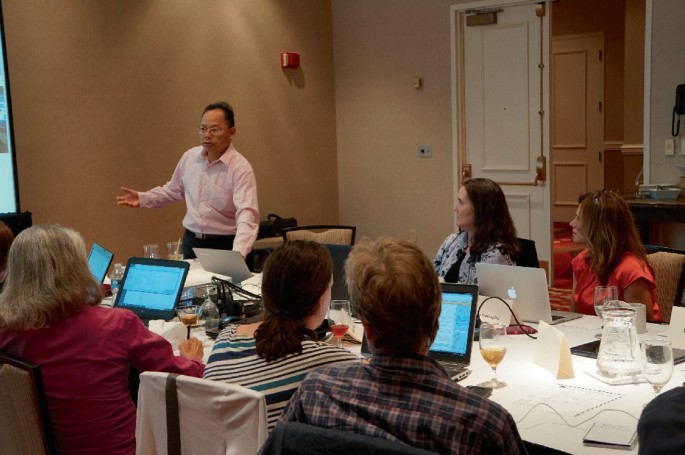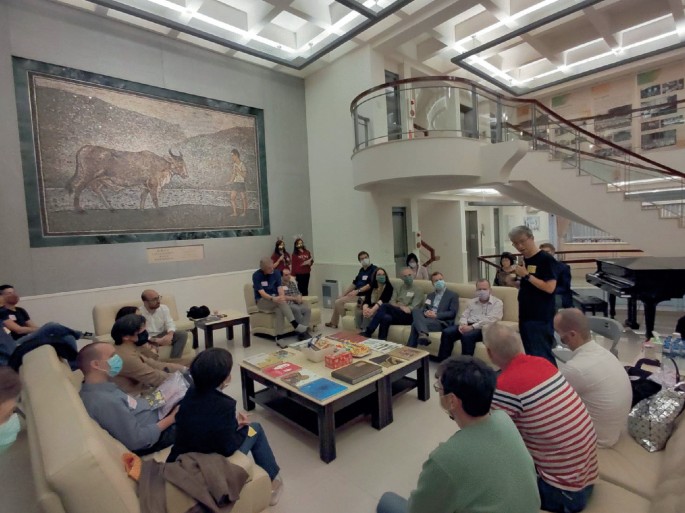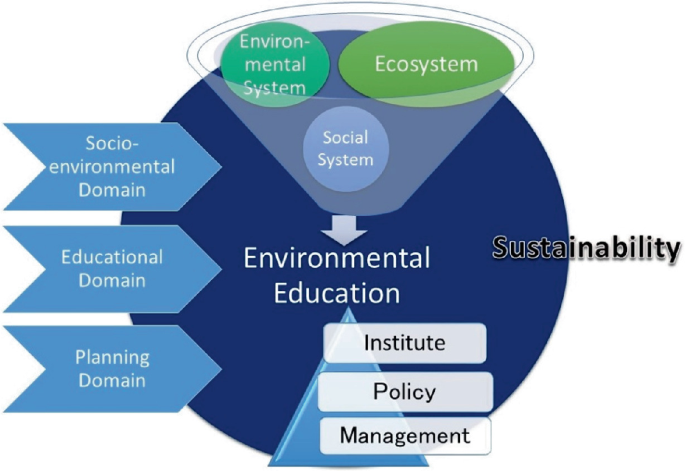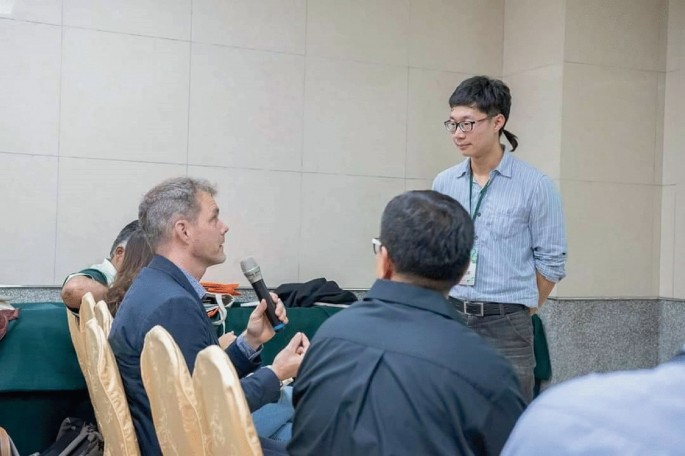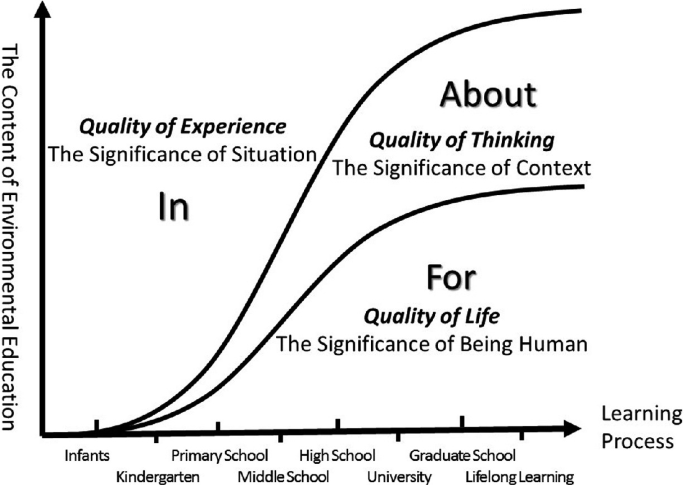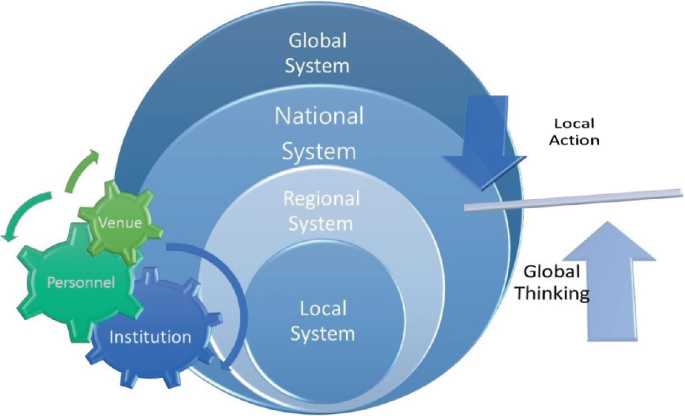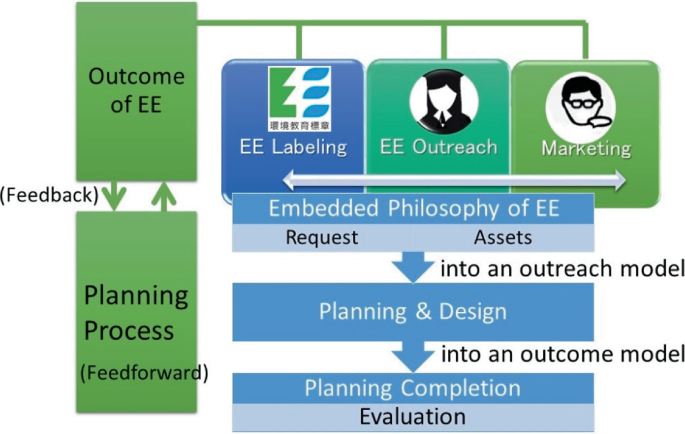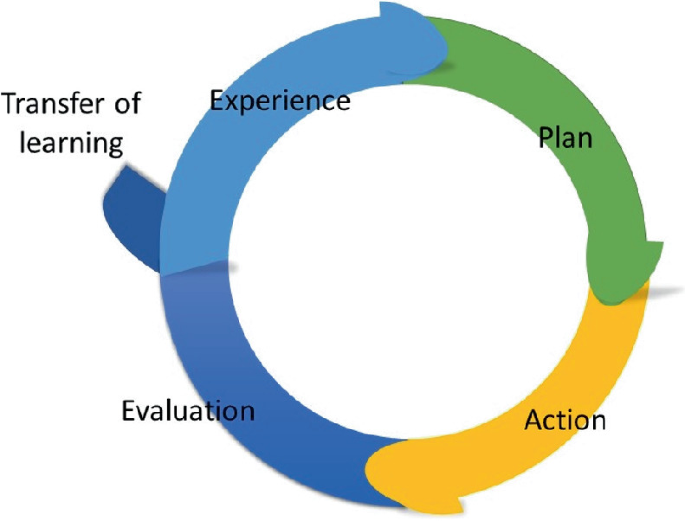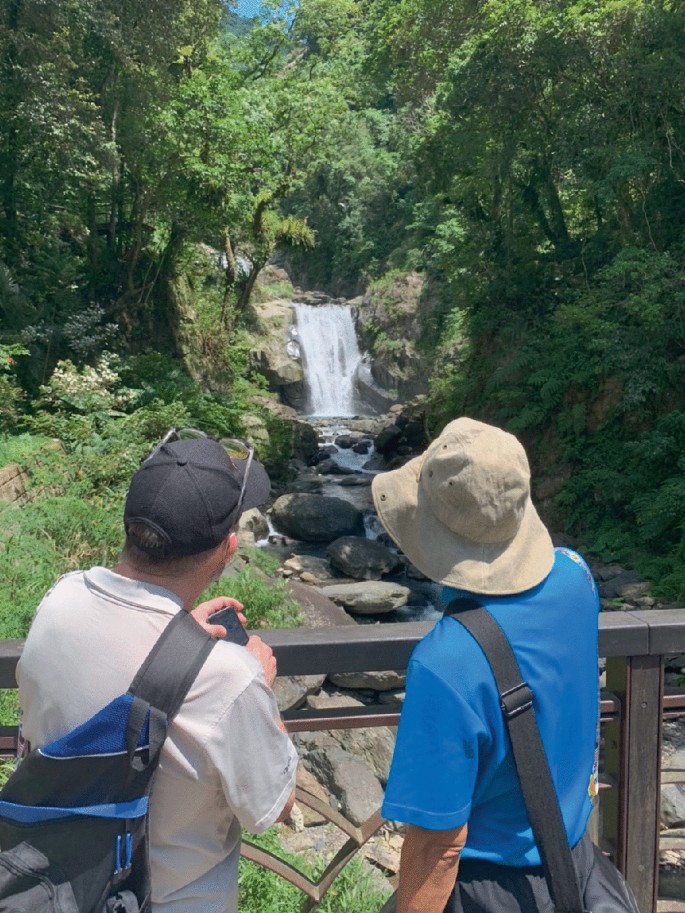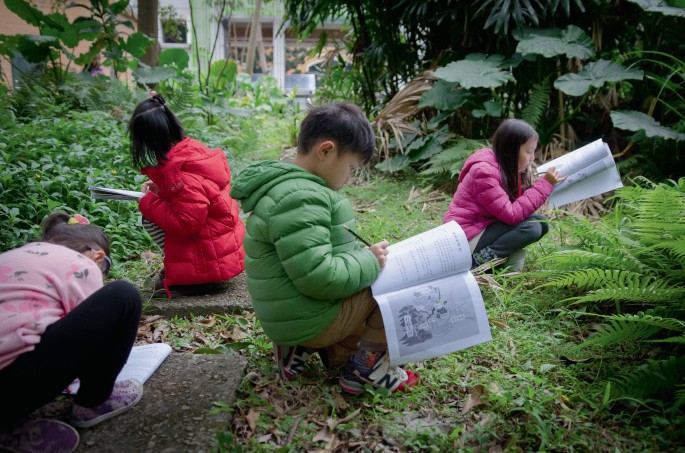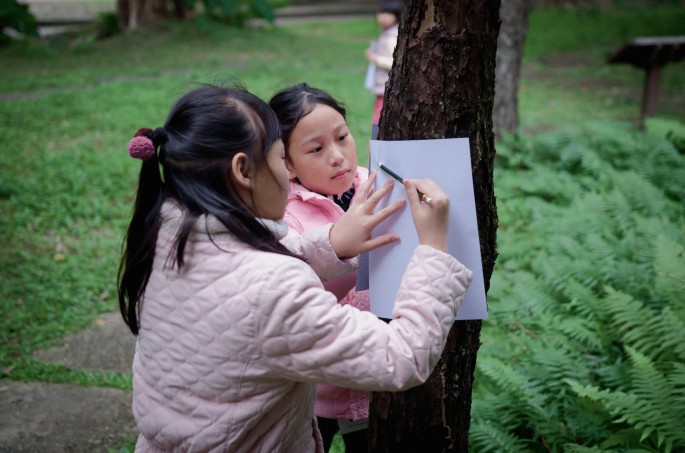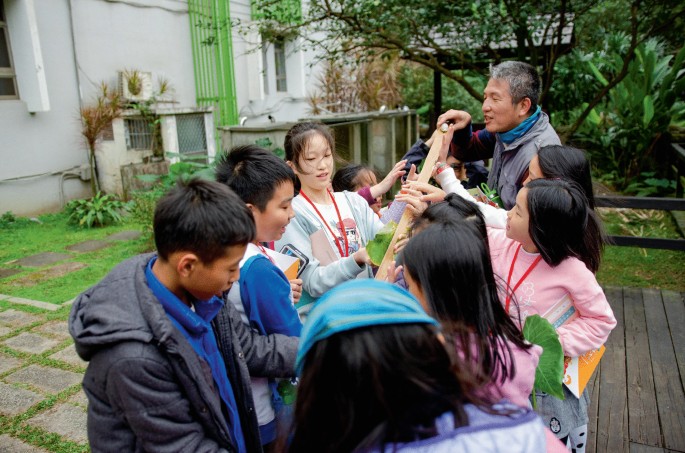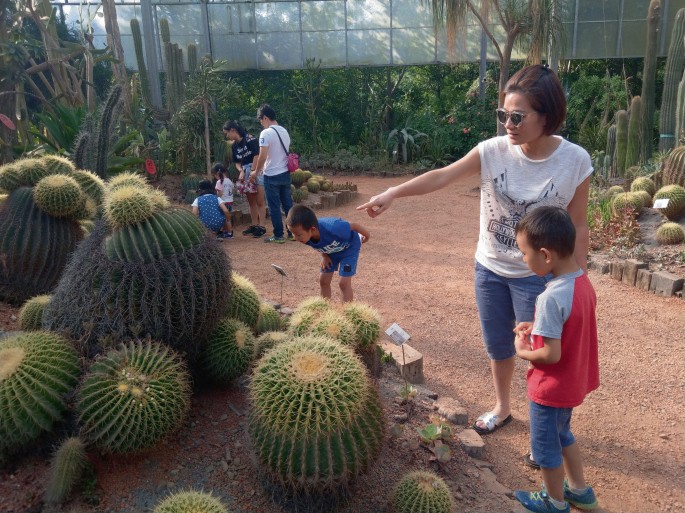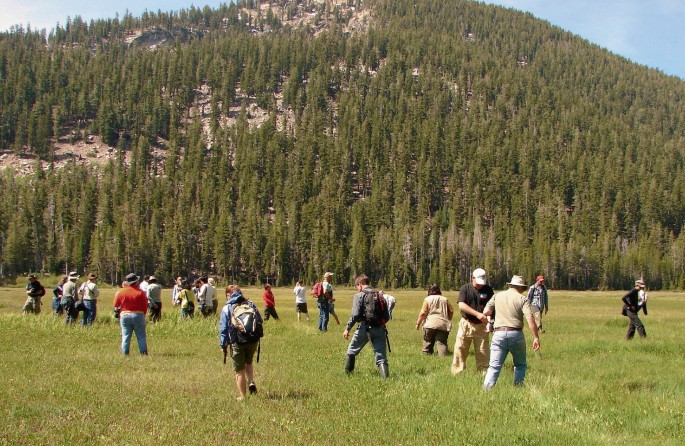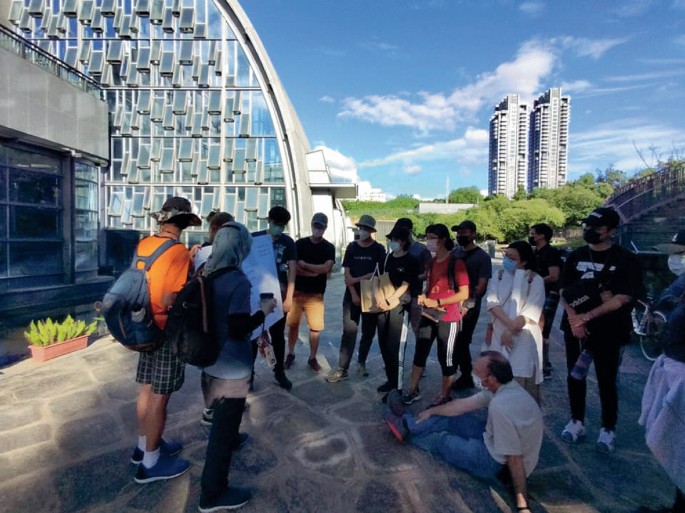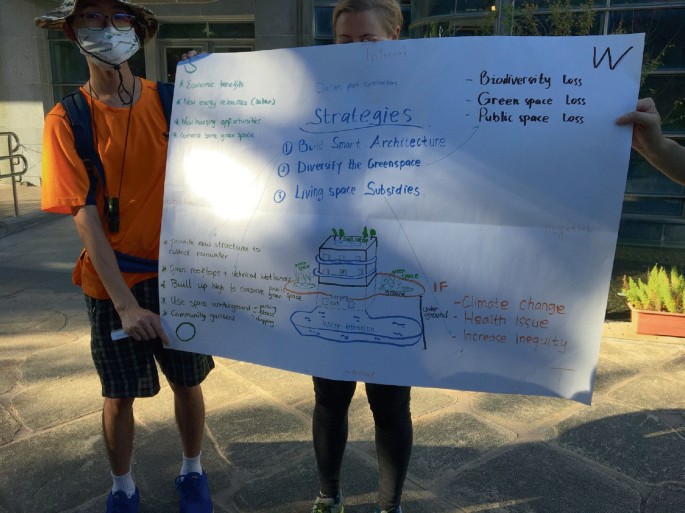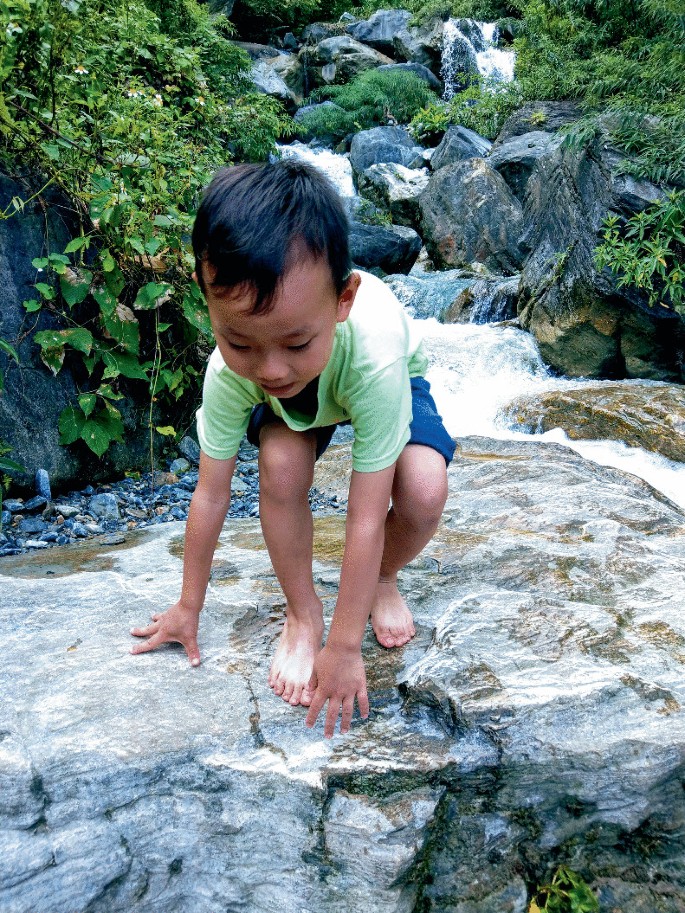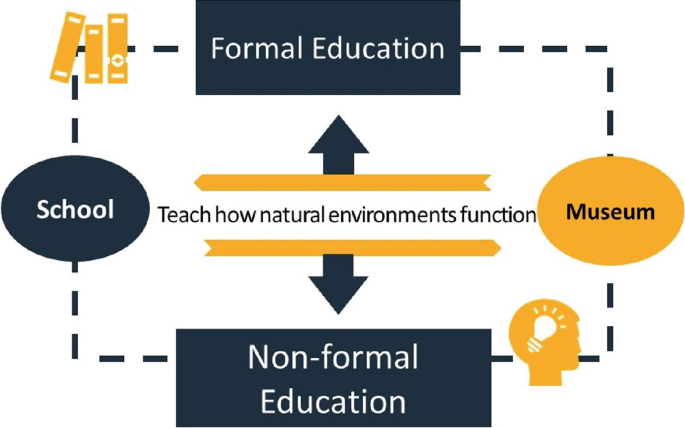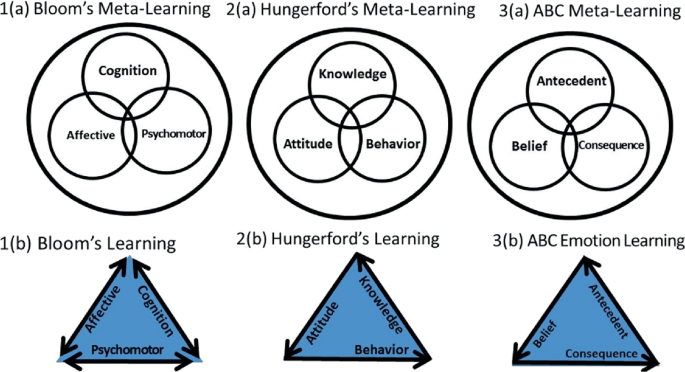Abstract
Research methods are the sum of knowledge, plans, strategies, tools, steps, and processes. In this chapter, we seek to understand the “research” nature of Environmental Education (EE), define the scope of research through a systematic investigation process by gathering and understanding past facts and discovering new facts through practical investigations, experiments, and verification methods to increase or modify the contemporary know-how in our environment. After exploring the history of EE, entering quantitative research on EE and qualitative research on EE, we use this chapter to improve the level of thinking of EE theory, using the learning methods of Benjamin S. Bloom, Harold R. Hungerford, and the emotional learning theory of ABC. We aim to understand the value of post-environmental learning, strengthen our transcendental cognition of animate and inanimate objects by looking at these aspects objectively and have a more general and mature view of the biotic and abiotic processes that shape the world around us.
At “Environmental education is the process of recognizing values and clarifying concepts to develop skills and attitudes necessary to understand and appreciate the inter-relatedness among man [sic], his culture , and his biophysical surroundings. Environmental education also entails practice in decision -making and self-formulation of a code of behaviour about issues concerning environmental quality .”
UNESCO, International Working Meeting on Environmental Education in the School Curriculum, 1970
You have full access to this open access chapter, Download chapter PDF
Similar content being viewed by others
1 What is Environmental Education Research?
In the previous chapter we mentioned that environmental educators must present the new and growing body of scientific knowledge and technologies to their students to meet changing social, economic, and cultural needs. The foundation of the environmental knowledge and the challenges facing environmental educators required for teachers and scientists today, is to re-examine the way we perform research, assess the questions that are relevant to modern issues, and to train EE professionals and educators (Fig. 3.1). We generate about 2.5 quintillion bytes of data daily (Humbetov 2021; Roque and Ram 2019), but most are out of touch with current and future societal, economic, and global environmental issues. Our environmental conditions are changing daily; some are normal and have been seen throughout Earth’s history. Human activities are simply accelerating a process that is occurring naturally. We may not necessarily know the exact time of a volcanic explosion or earthquake, but have a good idea on when they could happen based on past occurrences. This unfortunately does not meet society’s expectations on our ability to more accurately predict these changes based on the trajectory of the amount of data we’ve generated, technological improvements, societal expectations of the modern environment. Society is gob-smacked when scientists and educators can’t solve or explain environmental problems like global warming to the public in a way that they understand. Is it possible for the scientific community and environmental educators to distill complex environmental concepts, the problems and potential solutions, and correctly communicate them to the general public without creating panic? Therefore, in defining the goals of EE, we should strive to establish a professional standard for EE and the educators, and strengthen the standards needed for EE (Hudson 2001).
As scientists and educators, we have the opportunity and responsibility to expand the resource base of EE. Professor Fang sharing the Asia Chapter lessons learned and progress at an annual Society of Wetland Scientists (SWS) board meeting in 2015, from far left to right-sided: Wei-Ta Fang (Graduate Institute of Environmental Education, National Taiwan Normal University), Beth A. Middleton (Wetland and Aquatic Research Center, U.S. Geological Survey), Loretta Battaglia (Center for Coastal Studies, Texas A&M University-Corpus Christi) (Photo by Yung-Nane Yang)
So, in terms of a basic learning plan, what is the “research” of EE? After we have defined the state of the art and the scope of our research, we then strive to validate, dispel, increase, and/or modify contemporary environmental knowledge through a systematic investigation process, by collating and understanding past facts, and discovering new facts based on actual investigations, experiments, and verification methods. Therefore, we need to understand the personnel, culture, societal norms and values in space and in time, organizations, and materials in the environment using scientific and social science methods to analyze environmental issues, and to use these tools to develop a broad-based EE research program to address current and future needs. The needs of educational research are important.
Public education for the environment should have a positive impact on life in the future. Therefore, according to the concept of sustainable development, if our current and future generations want to enjoy the benefits of the planet’s natural heritage, EE must then be taken seriously. In the face of the increasingly cumbersome and complex issues of the twenty-first century, environmental problems are becoming increasingly difficult to understand and evaluate, but we need to become more heteroglossic to be effectively solve environmental problems. Heteroglossia however, has a problem of creating social controversies (Bakhtin 1981, 1994; Guez 2010). Science and EE is not immune to heteroglossia. Scientific reasoning and rational interpretation and analysis of environmental problems can be solved, but each person and/or organization has their own opinion and interpretation of complex environmental issues that are communicated at levels that are appropriate and targeted to different audiences, while others are not. Despite having messaging that is appropriate to one group of stakeholders, other groups may “hear or understand” the message differently.
Operationally and from an environmental point of view, human beings often adopt non-sustainable resource use and management methods to deal with economic development. The quality of our environment is often the victim of politically-vested interests of the public agenda. Therefore, as environmental educators our challenge now is how to express the complexity of modern environmental problems in an understandable way using simple and understandable methods, while ensuring that the environmental science is accurate and effective in interpreting and assessing environmental problems without inciting panic. This requires a carefully crafted communications plan and potential solutions for the environmental problems being faced that has consensus among stakeholders.
Therefore, although we study the environment, we need to follow a process that includes a literature review, a list of the problems that have been identified in the literature, new ideas, assess, and understand processes to determine whether the data collection, analyses, and interpretations are reasonable and feasible, and where improvement is needed. The most important thing to remember is that when we observe the environment, we interpret our observations from the societal norms, values, and constructs that we are a part of, while recognizing these elements are spatially and temporally variable, in addition to theoretical estimation and speculation. The research of EE must of course be based on theory and must be corroborated by sound science, practical analyses, and summarized and organized in a manner that the public at large can understand and when appropriate, contribute to developing solutions or the discussion. The following issues need to be emphasized when combing research methods (Estabrooks 2001):
1.1 Instrumental Research Utilization
Instrumental research is the application of specific research results and transforming them into materials that are suitable for EE.
1.2 Conceptual Research Utilization
It is said that research may change one's thinking, but it does not necessarily change one's behavior (Heimlich and Ardoin 2008). Heimlich and Ardoin (2008) declared that human behavior is grounded in rational thought. Why environmental education is not effective? How it could be more effective? In this case, it is necessary to inform decision makers of the research, what the results mean, and then let the decision makers ponder why EE is not effective.
1.3 Symbolic Research Utilization
Conceptually, environmental education research is often abstract and based on paradigms that fit the social and economic needs of human populations in space and in time (Stevenson 2007; Ardoin et al. 2013, 2020) The scientific and environmental concepts that are studied and ultimately presented to the public are explained or framed in a manner that pushes the science forward, but not too quickly or in a manner that society will lose interest or consider the results irrelevant to the problems society faces at that time (Ardoin et al. 2020). For example, the global change issues that we are concerned with today were not prevalent 100 years ago. Evolution was not accepted as a valid hypothesis until Darwin’s (1859) seminal work that appeared in the On the Origin of Species (1859), and even today, there are sectors of society that do not accept this hypothesis that shapes all life on the planet. Environmental education is the persuasive summary of what we know to be true, which in turn regulates human environmental behavior from actionable knowledge (Mach et al. 2020). Therefore, the scientific community and stakeholders need to develop processes where existing and new environmental/scientific data are collated, made relevant to society so that educational pedagogies and policies can be developed for the benefit of humans and the environment.
Therefore, research on EE must first emphasize the importance of the relevant topics, including the value of assessing the state of the art (all that is known on a topic) (Freeman III 1986), the problem statement (uncertainties or gaps) (Zehr 1999), the research to fill the gaps, and the writing stage (dissertations and peer-reviewed publications). Building on what is known is the process that the scientific community has followed for hundreds of years. It follows a process that helps scientists recognize emerging and important issues discussed by the international academic community (Fig. 3.2). Second, EE research requires an in-depth analysis of disputes (Lucas 1980; Tilbury 1995; Van Weelie and Wals 2002). In order to conduct logical dialectics, we need to propose a preliminary analysis structure, think repeatedly, and demonstrate the ability to control the research object. Third, in research, the research goals should be as specific as possible to avoid vague descriptions. In addition, performance needs to be measured, and currently this is based on the quality of academic research results published, important personal contributions, talent cultivation, and the research team’s academic community building and service experience (Estabrooks 2001). Although these elements are of the utmost importance, a dichotomy between science and the public is created (Eden 2010). The distillation and presentation of new ideas and relevance of the scientific data to the public at large is generally not considered important in academia. Environmental/science educators are then tasked with interpreting and translating the results generated in academia to the stakeholders, including and the public. This task is often difficult given that the goals of academia and society are generally not aligned.
From the discussions of education scholars with all folks, we understand that education is an educational activity that develops theory from practice from brainstorming to face-to-face communication (Person standing on the right side: President Cheng-Chih Wu, National Taiwan Normal University, Taiwan, 2022) (Photo by Wei-Ta Fang)
When the physical environment refers to something other than human beings, it is necessary to define the environmental boundaries or what is the environment. We can consider brainstorming as a form of productive discussion. EE emphasizes the importance of close cooperation between professional teams, local people, and stakeholders in a face-to-face setting to establish lines of communication, the exchange of ideas opinions, and trust. As a result, these types of local engagements or personal relationships are considered more effective than written documents (Wang et al. 2021). In addition, EE advocates the need for appropriate planning to experience the natural environment and promote concepts of environmental protection based on novel ideas. In the education process, continuous improvement of teaching skills encourages understanding the rapid changes in the environment and environmental conditions are needed to respond to the development of pedagogies focused on teaching environmental aspects. Therefore, regardless of the interaction between the individual and the environment, whether the individual cares for the environment or not, we must grasp the “initial intention” (Bratman 1981) that human beings generally benefit from the environment and the resources it provides.
According to the Avatamsaka Sutra 《華嚴經》 (V.17, in Chinese “Huayan,” in the late third or the fourth century CE) (Gimello 2005): “Those who traverse the three times in the worlds, you never forget why you started,”. In V. 19 it is said: “Like a bodhisattva’s original heart, it is not the same as the latter heart.” Later generations summarized their original intentions, explaining that “without forgetting their original intentions, they can always be obtained; their initial intentions are easy to obtain and always difficult to keep.” Therefore, in the process of EE, it is inevitable to feel lonely, because this is a lonely job (Hart 2002). The hardest part of doing any work that is beneficial to environmental protection is persistence, hoping to communicate hard, and persevere; endure the torment, and be able to win.
Therefore, in a team setting we need to establish good and clear lines of communication and collaboration for the course development team. In the initial stage of curriculum development, when the needs of learners cannot be fully collected, it is necessary to periodically review and adjust the needs of the people and adjust the curriculum based on feedback (Bester et al. 2017), which is a focus on the practical process of truth-seeking (Ansori et al. 2020). Research can be monetarily and intellectually expensive and could drive or impede the research questions being asked. Therefore, in the process of conducting research, even if in a vacuum, it’s important to stay on task and follow through on your original intentions and ideas. Building theory around hypotheses is challenging because changing paradigms not only requires the sound science to support new ideas, but acceptance of new ideas and in some cases changes in human behavior are needed. In addition to detailed observation, analysis, discussion, and constant self-criticism, it is also necessary to use seek the gift of feedback from one’s peers to modify better shape the initial theoretical prototype. Environmental education is structured around a mutually coordinated framework to achieve the goal of sustainable development. For details, please refer to Fig. 3.3.
2 Types of Environmental Education Research
The term EE appeared in 1947. When we talk about EE research, we think we need to break the question down. That is, what exactly is EE research? The mission of EE research is to promote research and academic understanding of EE and education around the goals of sustainable development. These goals are achieved by publishing one’s research findings in peer-reviewed journals. These journals were developed from EE programs and scientists across the globe. Many are founded on outstanding schools of education thought and practice and have been able to adapt to philosophical changes in space and in time (Stewart 2020). Therefore, it is important to identify journal philosophies, practical EE experience, education for sustainable development (ESD) goals, and the government policies that helped create the ecosystem around the science of the research and high-quality innovative papers from a new social contract (Lubchenco 1998). It is important to determine whether the scientists and editors are driving the direction of the science or it’s a question of dollars. Publishing houses businesses that like newspapers, are focused on generating revenue. The agencies that are providing the research funding are reacting to public pressure. The scientists then find themselves in a political, economic, and ethical mire because they need to follow the money and publish in the right type of journal. As the liaison between the academic community, stakeholders, and the public, environmental educators find themselves acting as sheriffs, lawyers, politicians, priests, and/or therapists in the process of distilling and disseminating the results of environmental study research and the meaning of these data to their students, stakeholders, and public.
2.1 International Periodicals
The Journal of Environmental Education (JEE) was founded in 1969 and Stapp (1969: 30–31) published an article within which EE was defined. The journal was dedicated to the research and development of environmental protection communications, highlighting the opportunity of the media to attract public attention to environmental conditions and issues. The mission of JEE was to provide a critical and constructive forum for research on the theory and practice of environmental and sustainable education. Today JEE publishes articles on EE experience and theoretical analysis, including critical, conceptual, or policy analyses articles on environmental or sustainability-related education edited by Alberto (Tico) Arenas, Editor in Chief, the faculty of the Environmental and Sustainability Education in the College of Education, University of Arizona, USA. Arenas received his Ph.D. at the fields of Sociocultural Studies in Education at the University of California, Berkeley. Papers are interdisciplinary and cover research that ranges from early childhood to higher education, formal to informal approaches, literature reviews, and program evaluations.
A second influential journal, Environmental Education Research (EER) was founded in 1995 and the papers published in this journal are often literature reviews highlighting innovative empirical and theoretical research approaches, and papers within which key concepts and of EE and Sustainable Development Education (SDE) methods are analyzed (see Fig. 3.4). The JEE and EER provide readers with perspectives on EE theory and methodology. Their purpose is to improve research and practice on EE and SDE topics. The research published encourages examining methodological issues and challenges to the existing theoretical dialogue. New articles provide in-depth connections between theory and practice and strengthen the conceptual framework across disciplines. Both journals welcome reader responses to published papers to attract ideas and generate academic dialogue that promote the theory and practice of EE and SDE research.
Environmental Education Research (EER) was founded in 1995 and the papers published in this journal are often literature reviews highlighting innovative empirical and theoretical research approaches. Left: Alan Reid (Faculty of Education, Monash University, Australia), the Editor of EER, inquired one of the Ph.D. students, Chia-Huan Hsu (Right), during the Taiwan’s EE Conference, Jianshanpi Jiangnan Resort, Tainan, Taiwan in 2018 (Photo courtesy of Yi-Hsuan (Tim) Hsu, Middle, back to photographer) (Photo by Wei-Ta Fang)
We reviewed research articles published in EER and JEE and all of the papers that we reviewed were based on international problems, such as climate change, global warming, sustainable development goals (SDGs), and empirical articles that included critical analyses and discussions of the research methods and findings. Conclusions and suggestions are based on policy practice derogation. As such, according to the papers published in the JEE and EER, EE and SDE have a wide range of research content, including critical articles and analyses on education policy, philosophy, theory, and history. In addition, articles within which qualitative analyses and verification of the reliability and validity of the analyses that were performed are predominant. Data on program evaluations show the progress of innovation in this field (Reid and Scott 2013), explains program goals, and record the background, processes, and research results. These results are based on the consistency and empirical nature of the arguments and can be extended to other educational and cultural backgrounds.
2.2 Local Periodicals
In the Sinophone society there are not many journals that are focused on EE research, but they are becoming more prominent. The Journal of Environmental Education Research published by the Chinese Society for Environmental Education (CSEE) in Taiwan was launched in 2003 and contains research papers that address a variety of topics, including educational discourses and environmental philosophical works. The main contents include:
-
Research Articles: Reports on scientific research,
-
Academic Articles: Reviews on EE research and practices; and
-
Essays and Analyses: Discourses on the historical development, ideas, practices, and philosophy of EE.
Environmental education, as defined in the Journal of Environmental Education Research (JEER), edited by Shin-Cheng Yeh at GIEE, NTNU, is extensive and includes “formal” and “informal” EE. Topics can cover a variety of environmentally related subject areas, such as: environmental ethics, environmental philosophy, sociology, psychology, commentary, communication, economics, planning and design, science and engineering, tourism, leisure and recreation, natural resource management, geography, culture and history, sustainable development, public health, food and agriculture (https://www.ipress.tw/J0088?pWebID=54) (in Chinese). Approaches to propose/test/assess theories and practices of EE policy, curriculum planning, or teaching and learning from multiple perspectives are the focus of the papers published in JEER.
2.3 Research on Environmental Education
In the aforementioned discussion the development of international EE is akin to a tree Joy Palmer (1951–) used to compare the content and development direction of EE. He believed that EE in the twenty-first century is based on the roots of trees, some shallow, some deep, but prevalent in the soil. On this basis, students should understand the environment, possess environmental knowledge, skills, and values, and develop the ability to take care of the environment (Palmer 1998).
2.3.1 Theme of Environmental Education
Project Environment was implemented in the UK in 1974 and mentioned three topics: “education about the environment,” “education in/from the environment,” and “education for the environment” (Tilbury 1995; Palmer 1998). However, how can teachers use the spirit of suspicion, curiosity, and exploration in the development of EE to conduct ecological surveys under different hypothetical situations and attract students towards the field of scientific investigation in a tempting manner? In reality it comes down to what a person/teacher wants to achieve? Do they want to teach students how to perform outdoor teaching projects based on critical and creative thinking, integrate past experiences and ongoing course learning content, and/or use education and research to develop the process? At the present time, in the process of developing education and research teaching, the following three directions are mainly discussed through instructivism, constructivism, and deconstructionism.
-
Education about the Environment
The aim of EE is to teach students about the environment, let them understand environmental concepts, and to allow them to criticize issues in a logical and constructive manner. This approach needs to generate critical thinking and problem-solving abilities by building on existing environmental knowledge and developing an awareness of the biotic and abiotic elements of the world around them. Therefore, EE is to seek and discover the essence of environmental research by developing and testing hypotheses. Learning to identify environmental problems that society faces today and then formulate relevant questions is a learned process. Under the guidance of teachers, colleagues, and peers, information about the environment is collected that will form the foundation of the research being performed. Therefore, education about the environment is a type of guided EE.
-
Education in or from the Environment
The field of EE emphasizing outdoor education is important. Teachers teach students to use the natural environment for learning; nature is a classroom and we can use our natural curiosity for inquiry and discovery to strengthen the learning process (Chang and Ow 2022). In the learning process, we integrate environmental awareness, research data, and personal experience to develop environmental awareness and solve environmental problems. Using this model, an awareness is built around our knowledge and experience with the environment.
-
Education for the Environment
At this stage, we have the experience that the environment is the cause and human beings are the effect; or human beings are the cause and environment is the effect. From the deconstruction approach, teachers can encourage students to study the relationships between individuals and the environment. Through the screening and discussion of environmental issues, students can begin to understand the causes of environmental pollution and encouraged to integrate environmental responsibility and action into their behaviors.
-
Education about, in, and for the Environment
The focus of EE still needs to be integrated into a unified system because most educational processes, from knowledge to competence and construction, are full of divides. That is to say, the curved lines in Fig. 3.5 are all EE content and can achieve the goal of sustainability through education. In other words, the concept of EE is high, but after a student receive EE instruction of EE, does it produce an ethical value that has for the environment, cultivate the correct knowledge, build the ability to improve the environment, integrate a sense of environmental responsibility, and generate actions resulting in stronger environmental awareness? This is the ideal scenario for “about, in, and for” EE. Integrated EE learning and research can cultivate actions oriented towards developing problem-solving skills and knowledge that form environmental attitudes and values that contribute to the formation of responsible environmental behaviors (Fig. 3.5). Therefore, integrated EE is a process that develops environmental attitudes, values, morals, and ethics and educates students develop an awareness and behaviors in people that care, want to be close, and protect the environment through different learning processes.
2.3.2 Proposals for Environmental Education
Environmental education emphasizes self-learning and in academia, self-directed learning is expected. In-depth study is conducted based on the interaction of learning methods, situations, and free choice (Falk et al. 2009; Falk 2017). Learners are free to design personal education plans for their environment through autodidacticism. However, because people have the inclination to be liked, disliked, and work hard, all the previous situations are ideal learning methods for social environmental education. Therefore, how do we educate kindergarten, elementary school to middle school, and college students in the formal environmental setting? How do we integrate knowledge and experience into learning experiences and encourage learners understand the environment around them and the resources provided by these ecosystems? This is explained further.
-
Instructivism
“Instructivism” is the approach of “guidance” that is advocated in the early stages of EE courses. It is based on the premise that teachers establish/provide the necessary learning resources and restrictions for students, set learning goals, understand themselves the principles of EE, design teaching methods that will allow students to attain the program goals and objectives, and emphasize the importance of professional knowledge learning in the curriculum goals. Instructivism provides a learning approach where students learn about the environment based on stimuli that emphasizes EE is a discipline within the constructs of ecology. Teachers must present the learning content in the way that meets the goals and objectives of the curriculum and use the appropriate tests to measure whether the students grasped the concepts and further expanded their knowledge and abilities on the information presented.
Under the notion of guiding theory of media richness by Chao et al. (2020), communication can still take place, but the scope will expand in concert with that of the knowledge field, allowing scholars and graduate students to gradually understand their own capabilities and vision from computer-mediated communication (Chao et al. 2020). Based on guidance-based learning, it is emphasized that learning is a two-way contract learning between teachers and students, rather than one-way teachers exerting their teaching authority. The learning contract is a kind of autonomous learning (autodidacticism), allowing learners to accept two-way contracts on their own, and teachers and students accept each other. In the integration of instructionalism into learning, based on the connection between “stimulus-and-response” (S-R), scholars are encouraged to try mistakes, and teachers can correct mistakes, and through the process of guidance, perform wrong learning and correct answer problems.
-
Constructivism
Constructivism is a philosophical idea derived from cognitionism and adopts a philosophical stand of “non-objectivism.” Constructivists believe that the ability to generate knowledge needs to pass through the actual field. Although the ecological environment of the so-called EE field exists objectively, the human understanding of ecology and the meaning given to it are determined by individuals. Therefore, human beings construct the concept of “environment” with their own experience.
Constructivist learning is a self-learning theory that scholars should establish after accumulating the basic work of self-learning. While constructivism and instructivism help students to acquire knowledge, constructivism adopts an open-ended learning method and instructivism adopts problem-solving learning method (Edelson et al. 1996; Herrington and Standen 1999). Their educational concepts are different and Constructivists believe that the learning method of EE is closer to that in nature (Klein and Merritt 1994). Students can learn on their own and build knowledge from observing and interacting with the environment. Therefore, the study of natural ecological knowledge is an education in/from the environment. It is based on the experience and understanding of environmental situations.
Constructivists therefore believe that human beings choose for themselves and are responsible for those choices. This kind of thinking gives human-beings greater freedom, but they must also accept greater responsibility, which is close to the existentialist thinking mode. Existentialists believe that the meaning of human existence cannot be answered by rational thinking. Therefore, from the philosophical thinking of “non-objectivism,” we understand that learning in/from the environment is personal, independent, and self-awareness is learned from subjective experience, which is not what teachers can do.
Constructivism encourages learners to actively experiment, experience, and take further actions in ecological experiences through the approach of “personal and direct participation in environment.” This will complete the learning process of education. Knowledge of EE is “learning by observing nature,” rather than relying on teachers to teach in the classroom what students should and should not do. Therefore, constructivism hopes that when scholars are confronting the conflict between theory and practice, that they form a sense of responsibility in the living environment and seek solutions on their own.
-
Deconstructivism
Deconstructivism is a critical way of learning in the course advancement and growth education. We observe education about the environment and only teach what the environment is and cannot produce environmental actions. It is only a state of knowing and not doing. Education in/from the environment is integrated into the context of nature and the effects of nature connectedness, but whether knowledge and action can be generated as a result is still questioned by scholars (Tilbury 1995). We interpret the different perspectives and look for reasons for these conflicts. When dealing with classic narrative structures, it is best to interpret them in the existing context/setting (Gough and Price 2004). For example, from the deconstruction of any EE dissertation, the existence of a certain type of prototype is required.
However, even though the process of construction is perfect, it means that we have seen in our research the strong and powerful natural connection to nature and even reached the wonderful feeling of unity between heaven and man. However, from the perspective of critics there are deficiencies that need to be carried out by deconstructive criticism. Here, we quote the Discussion of the Equality of Things, Zhuangzi of ancient Zhuang Zhou (莊子; 莊周) (Zhuangzi, 369–286 BC), who said:
There is nothing in the world greater than the tip of autumn down, and nothing in the world smaller than Mt. Tai (泰山). There is no one longer-lived than an infant died young, and no one shorter-lived than Ancestor Peng (彭祖), Heaven and earth and I are born together; the myriad things and I are one.
In other words, in the context of the two things, in the so-called environment, in terms of Zhuangzi’s deconstruction, there is no absolute standard for all sizes; there is no absolute standard for the length of all time. From Zhuangzi’s deconstruction method of time and space in the natural environment, in the process of deconstruction of “EE” textbooks and teaching methods, “instructivism” in the classroom and “constructivism” in the environment have always been in opposition and have a tense relationship.
“Instructivism” is described as “students memorizing the ecological knowledge to be a clear and unquestionable state forced by teachers”; however, “constructivism” is described as “both teachers and students do not know what to do. Teachers are only concerned with the psychological activities of students while learning knowledge, and not keen to test whether students really understand and memorized the knowledge required in the environment.” Deconstructionists discuss the EE teaching model to guide questions and construct critical ideas and theories, so that students can further investigate and conduct research on controversial environmental issues and generate questions. However, deconstructionists sometimes find too many problems, have the ability to be critical, and cannot participate in the process of environmental improvement. They blame others for not understanding environmental protection, but all lack the ability to improve the environment and cannot be integrated into the actual mainstream society. Therefore, what we need is the fourth kind of doctrine, which is the integration doctrine of EE.
-
Integrationism
The fourth doctrine refers to the integrationism of education about, in, and for the environment. The aforementioned methods of education do not actively fight against environmental, economic, and social injustices (Tilbury 1995). Even when criticism is made, it is limited to anonymous criticism and dares not to openly make constructive EE theory and practical contributions. Therefore, from the ontology of western scholarship, we need is an integrationism approach when it comes to the epistemology of the environment. “Nature” is not an absolute condition but relative in space and in time. In the dualistic structure of deconstruction, scholars criticize that although deconstruction can be used for academic criticism, it is difficult to understand its true definition and often belongs to political criticism. Therefore, we need a more rigorous academic and practical basis to explore the real complex interaction modes in the environment.
When investigating “deconstructivism,” scholars should learn French philosopher Derrida's caring and self-reflection skills for the world. Through self-reflection, critical thinking, and group evaluation, he transforms from a virtual situation into an enlarged body of the real environment. Recognize that only through reflection and mirroring can we improve our prejudices and ideas, as well as strengthen the responsibility of the citizens of the earth through actions. In recent years, due to the emphasis on sustainable development and the promotion of education for sustainable development, the paradigm of educational research has shifted from an empirical paradigm to an ecological paradigm in the real world. Positivism has turned to critical theory and hermeneutics, so the connotation of EE is increasing. In other words, more social evidence, argumentation, criticism, interpretation, dialogue, and social participation are needed to respond to the changing trends of the times, see Table 3.1.
2.3.3 Research Directions of Environmental Education
-
Environmental Education Policy
Environmental Education is based on the following concepts of “One Planet, Environmental Justice, and Sustainable Development (Magraw and Lynch 2006; Habib 2013);” therefore, how to improve the environmental literacy of the entire population and the practice of responsible environmental behavior is an important developmental direction for national environmental policies and environmental governance (Fig. 3.6). At present, the national EE program is the basis for environmental literacy policies (Liu et al. 2015). It is formulated by the Environmental Protection Administration of the Executive Yuan (Environmental Protection Administration 2014), and consults with the Ministry of Education and other units, and reports to the Executive Yuan for approval of the Taiwan’s environmental education program to carry out. This EE programs have been designed to enhance citizens’ understanding and awareness of the world’s environmental challenges, as well as to encourage active participation in environmental protection and, sustainable development (Huang et al. 2021).
-
Environmental Education in the Schools
The school’s EE program aims to strengthen the nation’s establishment of environmental-related programs through the school system (from kindergartens, elementary schools, junior high schools, high schools to university undergraduates, graduate schools), classrooms, and outdoor environments. Environmental Education are built on a teachers’ environmental literacy of knowledge, attitudes, skills, and values.
-
Corporate Environmental Education
To promote corporate social responsibility, reduce environmental pollution and promote the recovery, regeneration or effective use of a producers' product(s), industry and government need to develop partnerships that promote environmental protection, improve employee environmental literacy, and environmental education.
-
Environmental Science Education
To strengthen the disciplines involved in the environmental sciences (e.g., ecology, geology, geography, conservation biology, resources technology, environmental engineering, environmental psychology, environmental politics, environmental society, environmental culture, environmental economy, and environmental engineering) science learning activities in the classroom, laboratory, and field must be organized in uncertain times (Wals et al. 2014; Kidman and Chang 2022). Environmental science education includes a good understanding of the living and physical aspects of the world around us.
-
In-Service Education
EE at communities is a process of disseminating environmental knowledge and skills from in-service education in society (le Roux and Ferreira 2005). Disseminating environmental knowledge and learned skills from learning fields such as museums, social education centers, EE facilities, ecotourism, community tours, and the visits strengthened the connotation of environmental literacy of community residents and In‐Service Education and Training (INSET) for teachers (le Roux and Ferreira 2005).
-
Environmental Philosophy
Environmental philosophy explores the relationship between natural environmental values, human dignity, animal welfare, and the interactions between humans and nature. Environmental philosophy includes environmental ethics, land morality, and the meaning of sustainable development. Environmental philosophy studies the earth’s ethics of earth resources, human depletion, environmental protection, and philosophical practice toward project planning, design, and evaluation (Fig. 3.7).
-
Environmental Interpretation
Environmental interpretation is suitable for non-formal EE. Through the strategy of environmental outdoor fields and to explain the planning and implementation of outdoor ecological basics, ecotourism, ecological guides, and outdoor education methods are used to communicate knowledge and strengthen the human and natural environment. Therefore, an interactive opportunity can inspire learners to improve their knowledge, attitude, and activity skills of environmental ecology.
-
Environmental Communication
Environmental communication is an activity that transmits environmental knowledge, methods, and thoughts through communication media, and cultivates environmental literacy for all. Environmental communication conveys the status and problems of environmental events and the creative process of multimedia forms such as text, sound, images, animations, and videos, that results in a tangible explanation of environmental protection. Environmental communication explores the symbols, discourses, and contextual relationships of environmental issues. The dissemination of environmental information through books, videos, media, and social networking platforms has aroused readers’ interest in environmental knowledge. Furthermore, Artificial Intelligence (AI) and digital technology will be a new topic for revolutionary transformation for EE research in science (Yeh et al. 2021; Stagg et al. 2022).
3 Research on the History of Environmental Education
Historical studies of EE can be traced back to the emergence of the fields of formal education and educational research (Gough 2012). If we study the history of EE, we can then use curriculum history or genealogy.
Generally speaking, the historical research of EE is a type of research that must first look for objective knowledge in archives. Topics related to the subject can be found in the library, documentary library, and computer network searches. How to explore the context of archives through archival retrieval systems has become a key factor in thinking about archive/metadata research. In the archive, we understand that the reason why we need to involve in EE is because of the threat of global environmental change. International conferences have mobilized scientists to think about how to save the planet from the scourge of global change. Therefore, the history of EE illustrates our efforts to survive. From the historical trajectory, it we can observe the change of human collective behavior and use the “structuralist and “post-structuralist” approaches” research on using historical data.
The process of these meetings is long. In 1972, the United Nations Conference on the Human Environment advocated “the importance of education.” The meeting stated that “Education in environmental matters, for the younger generation as well as adults, giving due consideration to the underprivileged, is essential in order to broaden the basis for an enlightened opinion and responsible conduct by individuals, enterprises and communities in protecting and improving the environment in its full human dimension.” The Tbilisi Declaration in 1977 participants, discussed and formalized the field of EE (Knapp 1995). The Earth Summit in Rio de Janeiro, Brazil, in June 1992. The meeting participants provided education, public awareness, and training for the global action plan on Basic Principles tabled in Agenda 21. However, in the Conference on Environment and Development, EE was focused on promoting sustainable development and improving people’s ability to solve environmental and development problems. Later, EE was called “education for sustainable development.” In 2009 the Bonn Declaration was developed and describes education for sustainable development and prescribes formal, non-formal, informal, vocational, and teacher education actions.
In many countries, the development of EE and the education for sustainable development (ESD) are different. Some scholars believe that “EE” has been diluted by “sustainable development education.” Knapp (1995: 9) concluded that a name change was not in the best interests of EE. But overall, because EE has expanded into the economic and social fields, EE has been able to deepen its promotion effect in the world. European scholars of EE have incorporated EE research into their ESD programs. If we make inferences with the above-mentioned historical analysis methods, we can then understand that the budding and robustness of EE originated in the 1960s.
3.1 The Rise of Environmental Education
The field of EE originated in the 1960s. As the global environment deteriorated, it threatened human development. In the 1960s, scientists increasingly paid attention to the increasing scientific and ecological problems of the environment, and the public's need to understand these problems. These problems include the growing pollution of land, air, and water. In addition, the world’s population is growing, and natural resources are continuously depleting. As explained by the Declaration of the United Nations Conference on the Human Environment, or Stockholm Declaration in 1972:
We see around us growing evidence of man-made harm in many regions of the earth: dangerous levels of pollution in water, air, earth, and living beings; major and undesirable disturbances to the ecological balance of the biosphere; destruction and depletion of irreplaceable resources; and gross deficiencies, harmful to the physical, mental and social health of man, in the man-made environment, particularly in the living and working environment.
If education comes first in environmental improvement, educational research can stimulate effective ways of thinking and discussing human beings facing environmental problems (Carson 1962). American scholars Rachel Carson (1907–1964), Garrett J. Hardin (1915–2003), and Paul R. Ehrlich (1932–) yelled loudly, hoping to include education in the environmental agenda. However, EE is not just a social issue, but an educational issue. In addition, the relationship between science education and EE is implicit. In view of the seriousness of environmental problems, scholars in the 1970s hoped to solve environmental problems with science and technology. But a few scientists believe that science and technology alone are not enough. Therefore, through environmental chemistry, ecology, geology, geography, conservation biology, resource technology, and environmental engineering, the problems of environmental hazards that have been disturbed, could not be solved. Human ecologist Stephen Boyden said in 1970 (Boyden 1970: 18):
The suggestion that all our problems will be solved through further scientific research is not only foolish, in fact dangerous. The environmental changes of our time have arisen out of the tremendous intensification of the interactions between cultural and natural processes. They can neither be considered left to the natural scientists nor as problems to be left to those concerned professionally with the phenomena of culture. All sectors of the community have a role to play, certain key groups have, at the present time, a special responsibility.
3.2 The Construction of Environmental Education
Since the 1970s, school education in western countries have incorporated ecological and environmental content into integrated teaching and incorporated it into the education curricula of schools at all levels. The Intergovernmental Biosphere Conferences in 1968 and 1970 both recommended EE should be incorporated into school curricula. Stapp (1969: 31) emphasized the relationship of the environment using four goals EE (Stapp et al. 1969: 31):
-
It is recognized that the human system is composed of human, cultural and ecological environments (Boyden 1970: 18). The biophysical environment is an integral part of the system, and humans can change the interrelationships of this system;
-
A broad understanding of natural and man-made biophysical environments and their role in contemporary society;
-
Basic understanding of the ecological and environmental problems facing human beings, how to solve them, and the responsibility of citizens and governments to work hard to solve problems; and
-
Attitudes about the quality of the biophysical environment, which will encourage citizens to participate in the solution of ecological and environmental problems.
According to Stapp and his colleagues, this method of education is different from conservation education (Boyden 1970: 18). Conservation education focuses primarily on natural resources, not on the community and its related issues. Therefore, EE is not only concerned with the natural environment, but also with the working environment, as well as human well-being (Stapp et al. 1969: 30). In 1970, Stapp was invited to participate in the Australian Academy of Science Conference and proposed a curriculum in Australia. He emphasizes curriculum development procedures and administrative strategies rather than professional philosophical analysis. The experimental direction of Stapp led the practical development of EE.
The definition and goals of EE form the basis of some other concepts in the field. For example, in September 1970, the First International Working Meeting on EE in the School Curriculum, accepted the definition of EE as follows (UNESCO 1970):
Environmental education is the process of recognizing values and clarifying concepts, in order to develop skills and attitudes necessary to understand and appreciate the interrelations among man, his attitude and his bio-physical surroundings. Environmental education also entails practice in decision making and self-formation of a code of behavior about issues concerning environmental quality.
3.3 Ideology of the Declaration on Environmental Education
Environmental science education, usually in the form of ecological concepts, are incorporated into school curricula. However, true EE and learning have not been regarded as a priority for education, because in the West, EE is valued by scientists, environmentalists, and scholars, but not by governments.
In addition, the drafters of the EE declaration are all men. Although EE is based on novel ideas no attention was paid to gender equality. For example, 1975 was the International Women’s Year and the United Nations issued non-sexist writing guidelines, hoping to use as much gender equality as possible in international declarations. For example, try to replace sex identification in the declaration with neutral words/descriptors. These instructions were followed writing the 1975 Belgrade Charter, but the 1977 Tbilisi Declaration didn’t, which would make this document discriminatory on the basis of gender identification. Although some women consider human male activities to be a major factor in environmental degradation, it is important that all human beings be regulated by EE statements.
3.4 The Practical Power of Environmental Education
In the historical demonstration of EE, the practical power of EE needs to be evidence-based practice through empirical research. In science education, empirical research requires an experimental group and a control group to conduct evidence inference by employing intervention. However, EE is not education of knowledge, but education of practice. In other words, practical education requires behavioral changes, but this behavioral change comes from a sincere change in the heart, not a short-term plan that can be manipulated in a classroom-based laboratory. Therefore, the experimental limits of EE have received considerable criticism for its research results (Blumstein and Saylan 2007). In recent years, EE research has been mainly discussed in terms of “positivism,” “post-positivism,” “structuralism,” or “hermeneutics” and “critical theory.”
The Frankfurt school Jürgen Habermas (1929–) has criticized the issue of instrumental rationality. His claim on epistemology holds that human knowledge can be divided into three types (Habermas 1971):
-
Scientific research of experience-analysis: including the cognitive interest of technology;
-
The scientific research of history-hermeneutics: including the cognitive interest of practice; and
-
Critically oriented research: contains the cognitive purpose of liberation.
It could be argued that students who advocate the supremacy of techno-science, don’t care about the environment. Therefore, if EE is an instrumental research utilization, which then means that through manipulation and intervention, one can change the way one thinks, which is empirical; but changing one’s way of thinking does not necessarily change one's practices. Therefore, we need to adopt conceptual research, which is based on Habermas’ “hermeneutics” and “critical theory.” Conceptual research requires the power of social practice, and its purpose is to confirm the relationship between practice in a social context. In social practices, researchers emphasize the promise of change. There are two forms of this kind of commitment: one is activity, and the other is inquiry. In other words, social practice is usually applied in the context of human development and involves knowledge production and theoretical analysis. This knowledge is the knowledge generated after practice. Therefore, how to use research from the physical world to make sense requires research procedures. In other words, we need research as a persuasive tool, which requires time and money. Our research on how to continue to grow over time requires long-term observations, hypotheses of behavioral intent, and a correct measure of how others respond. In social practice, environmental literacy is regarded as a key factor in human growth (see Chap. 4). The practical factors occur that produce environmental literacy with the material, meaning, and procedures of the human world. The aforementioned research must confirm that ontology/epistemology/methodology have different assumptions, and the constructed worldview is also different.
3.5 Reflection on Environmental Education
If we say, the practical power of EE is action research. Action research is a type of self-criticism under collective action (Fig. 3.8). The purpose of understanding how practitioners deal with matters in a social context is to improve the public interest of the entire population, generate social justice, and understand the meaning of practice (Kemmis and McTaggart 1982). Kemmis and McTaggart (1982) adopted a self-reflective circle that can be divided into four elements: plan, action, observation, and reflection, and the extension of the plan will continue to be revised by plan, action, observation, and reflection (Fig. 3.8). A detailed research guide and experimental design reference manual were designed based on the concept of the course of the circle of action research (Kemmis and McTaggart 1982). His plans, actions, observations, and reflections, through revising and improving the plan, produce a circle of re-action, forming the characteristics of the EE field to promote EE.
Box 3.1 Examples of Environmental Action Research in Taiwan in the 1990s
A self-reflective circle, which is divided the plan, action, observation, and reflection elements. This model is effectively a continuous improvement model where improvements/changes to the research and experimental design are made each time one moves around the circle. Therefore, according to the plan of the Environmental Protection Administration of the Executive Yuan (Taiwan EPA), how to promote campus ecological protection and community environmental protection, we cite the following case of the “National Little Environmental Planner” from Taiwan EPA.
-
1.
Planning Basis
First, to promote EE in schools and strengthen environmental protection education, the Environmental Protection Administration of the Executive Yuan (Taiwan EPA) began to hold a National Conference on Children’s Environmental Protection in 1990, which was expanded in 1991 and renamed the National Conference of “Little Environmental Protection Administrator.” From 1991 to 1997, a total of 4500 national elementary school students participated in the conference. Therefore, how to pay attention to environmental issues through the activities of the Little Administrator of Environmental Protection. How to protect the environment when problems occur in the campus environment or when problems are encountered during the implementation of EE. For example: “How to deal with the fact that the ponds on the campus are seriously eutrophicated and become a breeding ground for mosquitoes?”.
-
2.
Reference Methods
-
i.
From European and American countries: Environmental planning methods, planning theory, citizen participation, case studies, roundtable discussions, computer-aided mapping, report presentations, The Global Learning and Observations to Benefit the Environment Program (GLOBE).
-
ii.
Japan: Town making plan, drawing of the environment map of amenity, outdoor visits, etc.
-
iii.
Taiwan, Republic of China (Taiwan, ROC): Local teaching materials and teaching methods, off-school teaching, national science exhibitions, etc.
-
3.
Research Strategy
Think about the idea and solutions first. This project can be carried out from outside or inside the school. If it is outside the school, then start from the neighborhood, conduct environmental surveys, draw environmental maps, discuss urban and rural issues, and publish the research findings. When encountering environmental problems on campus, first perform the tasks and use scientific methods to collect information related to the issue, including expert interviews and detailed investigation. First, we can organize tasks and use scientific methods to collect information related to the issue, including expert interviews, data query, site surveys, questionnaires, etc. After the data are collected, we conduct preliminary consolidation (triage) and then use various democratic procedures, such as: conduct debates, discussions, and decisions to determine the best issue resolution method to use as a yardstick for follow-up action or provide it to administrative units for reference.
-
4.
Take-Action
Take-action based on the above-mentioned solution strategy, that is, “how do we manage to solve it by hand?” Therefore, under the promotion of the plan of the Little Environmental Planners nationwide in 1997, through the guidance of schools’ teachers and the guidance of college student associations, the mothers and all residents of the community were affected and promoted (Fig. 3.9).
-
5.
Reflective Thinking
Through “evaluation,” the actual implementation results of the strategy are resolved, and the results are reflected on reflection. At the beginning of the promotion of the plan, in 1997, this project was praised as an “unprecedented national EE plan.” Neighborhood neighborhoods started with a lot of interest, because planning in the United States started with towns and cities and communities.
-
6.
Government Action
-
(1)
In order to evaluate the performance of Little Environmental Protection Administrators of counties and cities in promoting environmental protection, the Taiwan EPA selected the first (the year of 1996) National Little Environmental Protection Administrators and arranged to meet with President Li Teng-Hui (1923–2020), Republic of China (Taiwan) at the Presidential Office and Record a TV show. In 1997, he promoted the “Little Environmental Planner” activity, using the four elements of planning, action, observation, and reflection. In response to the actual needs of social environment changes and EE, the “National Conference of Little Environmental Protection Administrators” organized by the Taiwan EPA. “The Little Environmental Protection Administrators Meeting” organized by the states focused on actually promoting environmental protection work as an educational focus, in line with the concept of “general transformation of the living environment, and discussed the format of holding. According to the Taiwan EPA and the Ministry of Education (MOE) compiling the “National Records of Excellent Little Environmental Protection Administrators,” and “Environmental Protection Seeds” in 1998, it is good to look for local environmental issues and uses various scientific methods to collect relevant information. After collecting the data, draw an environmental map, write a small paper, and promote local environmental improvement, including river research, coastal protection research, campus noise decibel research. There are 79 environmental planner reports regarding to “The Little Environmental Protection Administrators Meeting” on environmental studies of the elementary school with fruitful results.
-
(2)
After more than 30 years of education reform, the MOE has promoted twelve years of national education, and has made quality-oriented education a priority in EE. It is believed that the cooperation between school education and community development promotes the planned Curriculum Guidelines of 12-Year Basic Education of the Ministry of Education in Taiwan, Republic of China (ROC). Community cooperation perspective. EE has undergone a generation of educational reforms, from the promotion of neighborhood education to the integration of cross-regional cultures, forming a new situation. Environmental education from parents, through the struggle of science and practice, has produced the next generation of EE from infusion education to transformation education. That is:
The Sustainable Future Equation:
$$ \begin{aligned} & {\text{Sustainable future}} = ({\text{Awareness of unsustainable issues}} + {\text{Knowing how change}} \\ & \quad {\text{is detecting in our changing world}}) \times {\text{Purposed action}} \\ \end{aligned} $$
-
(1)
4 Quantitative Research on Environmental Education
Quantitative research on EE is mainly based on “positivism.” In the research, we attach importance to collecting evidence, conducting data analysis, using validity and reliability to strengthen the reliability of data, and using variable operations to control variables. Perform statistical analysis to describe the phenomena such as personnel, features, etc. to be discussed.
4.1 Preparation and Measurement of Questionnaires and Tests
The differences between the scale and the questionnaire and the compilation structure include the theoretical basis for the scale. The questionnaire is only required to meet the theme. Therefore, the compilation of the scale is based on the theory proposed by scholars to determine its content. The researcher compiles the questionnaire according to the following three steps: determining the subject, collecting information, and compiling the question. Once this information is collected the questionnaire can be developed.
To strengthen the validity of the questionnaire/scale, it is recommended to ask three EE scholars and experts to review the questionnaire, provide feedback, and discuss whether the questionnaire/scale topics need to be revised. The most common form of attitude measurement is the Likert five-point scale.
4.2 The Experimental Research Methods of Environmental Education
The experimental approaches can be repeated. Different experimenters can get the same results if the premises/assumptions are the same and the operation steps are the same. Experiments are usually published in the form of experimental reports. Due to the need for funding for the experiment, under the consideration of reducing the probability of experimental failure and reducing the cost of the experiment, the quantitative experiment should divide the experimental object into small phenomena; also, because the reality cannot be recognized by the experimenter, it needs to be cut into experiments one by one to analyze. Quantitative experimental research includes scientific experiments on EE, the methods of which are described below:
4.2.1 Observation and Formation of the Topic
After thinking about the EE topic of interest, researchers conduct research on the topic. The subject should not be selected randomly, but should be based on topics of interest. After selecting, you need to read many documents to fully understand what all the documents in this field include, in order to reduce information gaps. Therefore, the topic should be selected carefully, and the knowledge of that topic needs be connected.
-
Forming of Hypothesis: Specify hypothetical relationships between two or more variables, test them, and make predictions;
-
Conceptual Definition: Describe the concept and generates correlation with other concepts;
-
Operational Definition: Define the parameter variables and how to measure and evaluate parameters in research;
-
Gathering of Data: Include determining the size of the parent space, where the parent parameter is a statistical measurement and is unknown. The sample space is selected for parameter sampling distribution, and specific research instruments are used to gather information from these samples. Instruments used for information and data collection must be safe and reliable;
-
Analysis of Data: Analyze the data and interpret the results to summarize the conclusions;
-
Data Interpretation: Use tables, graphics, or photos to represent, and then describe in words; and
-
Testing and Revising of Hypothesis: Make conclusions and repeat operations if necessary (i.e., conclusion, reiteration if necessary).
As mentioned previously, empirical research in “science education” requires the establishment of an experimental group and a control group to conduct evidence inference utilizing intervention. However, “EE” is not a knowledge-based education, but a practical education. That is to say, it is difficult for EE to conduct psychological experiments in a classroom-type laboratory through short-term plans to get the answers we want. Therefore, the “experimental results” of EE require careful examination of the “empirical results” and careful verification.
4.2.2 Quasi-experimental Research Method of Environmental Education
It is difficult for the social sciences to adopt an “experimental research” approach; therefore, most research is “quasi-experimental design.” When researchers are unable to use random sampling methods to assign research subjects in educational situations and strictly control experimental situations, the ideal experimental design is to use “quasi-experimental design.” For example, if EE researchers have compiled a new “environmental education textbook,” they need to know whether this textbook is better than the traditional “EE” textbook. Researchers were unable to randomly select subjects from National Primary Schools and randomly assign them to experimental and control groups. However, when approaching the school, the researcher must use the quasi-experimental research method when the original class is used as the experimental object.
Therefore, the principle of “quasi-experimental research” design is “design of forward and backward measurement of unequal groups.” The experimental and control groups are classified as follows:
-
Experimental Group: pre-test (measurement before the experiment), test (experimental teaching, or new teaching of experimental “EE textbooks”), post-test (measurement after the experiment), delay test (in the measurements were taken three months after the experiment).
-
Control Group: pre-test (measurement before the experiment), test (without experimental teaching, or traditional teaching of experimental “EE materials”), post-test (measurement after the experiment), delayed test (measured three months after the experiment).
Although the above quasi-experimental design cannot control all the factors that affect the internal validity of the experiment like the actual experimental design, it can control most of them, and can avoid the experimental situation of EE that is too artificial if missing. In education research, there are four most commonly used quasi-experimental designs: (1) Unequal control group design; (2) Equivalent time sample design; (3) Adversarial equilibrium design; and (4) Time series design.
4.3 Reliability and Validity Analysis
4.3.1 Reliability
The purpose of reliability analysis is mainly to analyze the consistency of test results. Reliability refers to the consistency or stability of the results obtained by the testing tools (questionnaires/scales), and an indicator that reflects the true degree of the tested features. There are four main methods for reliability analysis:
-
Retest Reliability Method: The retest reliability method uses the same questionnaire and repeats the test at a certain interval for the same group of participants to calculate the correlation coefficient between the two test results. Because the retest reliability method needs to be tested twice for the same sample, the questionnaire survey is easily affected by events, activities, and subjects, and the interval is also limited, there are also certain difficulties in implementation.
-
Replica Reliability Method: The replica reliability method allows the same group of participants to fill out two copies of the questionnaire at one time, and calculates the correlation coefficient between the two copies. The reliability of replicas hopes that the two replicas are completely the same in terms of content, format, difficulty, and direction of the corresponding items, in addition to the different expression methods. In actual surveys, the questionnaires meet this requirement, so this method a bit less.
-
Half-Reliability Method: The half-reliability method is to divide the survey item into two parts, calculate the correlation coefficient of the scores of the two parts, and then estimate the reliability of the entire scale. Half-reliability is used for reliability analysis of attitude and opinion questionnaires. When performing a half-reliability analysis, if the scale contains reverse items, the scores of the reverse items should be reversed first to ensure the consistency of the scoring direction of each item, and then all items should be odd numbers. Or even, divide it into two parts that are as equal as possible, calculate the correlation coefficient between them, and finally get the reliability coefficient of the entire scale.
-
Alpha Reliability Coefficient Method: Cronbach alpha reliability coefficient is the most used reliability coefficient at present. The alpha coefficient is the consistency between the scores of various items in the scale, which is an inherent consistency coefficient. This method is suitable for reliability analysis of EE attitudes, opinion questionnaires (or scales).
4.3.2 Content Validity
Content validity refers to the appropriateness of the content of the test subject to the sampling of the relevant content, that is, whether a certain measured value can represent all the partial content of an event. The higher the content validity measurement, the more able it is to measure the content of EE textbooks, and the more able it is to measure whether the teaching goals are consistent with the original plan. The content of content validity verification requires a detailed logical analysis of the content being tested, so it is also called logical validity.
4.3.3 Criterion-Related Validity
If we study the relationship between environmental attitudes and behaviors, the validity of the correlation criterion then is to test the relationship between the measurement score and the actual attitude and behavior. Because the validity of the criterion requires actual evidence, it is also called empirical validity.
4.3.4 Construct Validity
Construction validity refers to the degree to which measurement results, also known as construct validity, can be consistent with theoretical concepts. This kind of validity is mainly to measure the degree of construction of a certain theory of environmental psychology, also known as the conceptual validity of the theory.
4.3.5 Degree of Difficulty
The degree of difficulty of the questionnaire refers to the difficulty of the question. Generally speaking, the knowledge and ability test can explain the difficulty of the test, but for the test of EE motivation, attitude, and personality traits, the difficulty refers to the rate of whether to answer the question.
4.3.6 Discrimination
Discrimination refers to the test questions, mainly environmental knowledge questions, whether it can distinguish the level of participants' ability, adopt internal consistency, arrange the participants in order of the total score, and take the top 25% of the highest score as the high group. Take the last 25% of the lowest score as the low group, and then find the correct answer rate of each question in the high and low groups, expressed as PH and PL, and D = (PH − PL) as the item's discrimination index (item) discrimination index). The D value is between −1.00 and +1.00. The larger the D value, the greater the degree of discrimination; the smaller the D value, the smaller the degree of discrimination; the D value of 0, which means no discrimination.
4.4 Retrospective Research
Ex-post facto research uses ex-post facto research to find out possible relationships or effects. Comparing retrospective research methods with experimental research methods, these two research methods are both looking for the relationship between the self-variant term and the dependent variable term. However, the self-variables of the retrospective study must be determined in advance before collecting data to explore the relationship with the observed variables. An analysis is usually performed using statistical records, personal files, and mass media reports. Therefore, ex post facto research is also called explanatory observational studies, or causal-comparative research.
4.5 Relevance Research
Correlation research is defined as the relationship between two (or more) variables that collectively change values. Statistical correlation refers to the degree of relationship between two groups or populations, or co-occurrence and interaction between variables. In statistical methods, Pearson correlation technology can be used to calculate the strength and direction of the relationship between variables, and we use correlation coefficients. Positive correlation and negative causation, respectively, represent the situation that when a value increases, the value associated with it also increases or decreases.
4.6 Data Analysis, Interpretation and Application, Presentation of Research Results
In the research, we will formulate research hypotheses. Data analyses mainly applies statistical methods, calculation of the existing relationships between the data, and draws out statistical diagrams to explain the meaning of the data. The data analyses explain the most useful part of the data and through the presentation of the research results, the application of the research results are used to transform the value of the research results for EE promotion.
4.7 The Research Method of Delphi
Besides setting assumptions for quantification to converge, other objective methods can also be used to deal with the construction of environmental indicators, such as using the “Delphi expert research method, which is a structured decision support technology”. During the information collection process, independent subjective judgments of experts are used to construct relatively objective opinions and suggestions, so the composition validity of the experts is important. The “Delphi Research Method” investigates in a way that experts do not meet each other until the opinions converge (Clark et al. 2020).
5 Qualitative Research on Environmental Education
The qualitative research of EE can be applied in the field of environmental social sciences. Qualitative research is a process of inquiry and construction of multiple realities. There are many kinds of qualitative research methods, and so far, there are still new methods, which are constantly being researched and explored. Qualitative research tools are mainly used by researchers to make long-term observations of research objects through the research area. Qualitative research requires interviews to understand the patterns of daily life of the participating researchers, analyze their social and cultural environment, and the impact of these environments on their thinking and behavior.
Therefore, the main purpose of qualitative research on EE is to understand the personal experience of the research object, the construction of its meaning, and “interpretive understanding” of the overall context in a certain environment. Researchers interpret their life stories and meaning construction through their own experience. Also, researchers need to reflect on whether they have research biases due to data limitations. In the actual research process, the researcher is a patchwork of social reality. If something happens only at a certain time and space, such patchwork will bias the data and subsequent analyses and interpretations. Therefore, the qualitative research results have a large subjective component, which is only applicable to specific situations and conditions, and cannot be inferred to the scope of the study area and the sample. That is, qualitative research focuses on understanding social and environmental events in a particular social context, rather than inferring situations like that event. In EE research, qualitative research often uses interviews, observations, grounded theory, action research, ethnography, and content analysis.
Of course, the above methods are not independent; it means that interview methods, observation methods, and other methods are also used in grounded theoretical research. The methods of qualitative research are rich and diverse, and they affect each other and are inexhaustible.
5.1 Interview
Interviews in qualitative research are a process of dialogue, asking questions to interviewees, and leading out meaningful messages for research and questions raised. Interviewing is a type of research-oriented conversation. It is a research method in which the researcher collects first-hand information from the research through oral conversation. The interview method is usually performed by a trained researcher, who asks the interviewees a series of interactive answers. In phenomenological or ethnographic research, interviews are often used to reveal the meaning of the center of life from the perspective of the interviewee. Because social science research involves human thoughts and ideas, interviews have become a very common and useful research method in social science research associated with questions (please see energy literacy scales and conceptual logic maps) (Yeh et al. 2017). The following methods are commonly used in interview methods.
5.1.1 Non-structured Interview
No predetermined outline of the interview was proposed to remain as open and compliant as possible to the priorities of the interviewee. In the interviews, the researchers took a “let it go” approach.
5.1.2 Structured Interview
The purpose of this approach is to ensure that each interview presents the same questions in the same order. This allows the interview data to be easily and reliably compiled and compared between different interviewees or between different survey dates.
5.1.3 Semi-structured Interview
Different from structured interviews, there is a rigorous and standardized interview outline that does not allow respondents to easily shift the focus; semi-structured interviews are open. Although there are still preliminary interviews, new questions are allowed during the interview process and ideas.
5.1.4 Focus Groups Interview
This is a qualitative form of research that can be divided into environmental expert interview methods and focus group clinical interview methods. Focus group interviews are groups of people who are asked about their views, opinions, or attitudes about something or something. In focus group interviews, participants are free to talk to each other or ask questions. In the process, researchers record what the participants mentioned in the conversation. Also, researchers should carefully select focus group interview members to obtain a more effective response. Focus group interviews have many advantages that individual interviews do not have, so they can play a more special role in research. These include: (1) “Interviews are themselves the object of research; (2) Collective inquiry into research issues; and (3) Collectively constructing knowledge.
5.2 Observation
Observation can be either quantitative or qualitative. Observation is a method of collecting data by observing people, events, or in the natural environment and recording their characteristics. Observation is a process in which human sense organs perceive things (see Fig. 3.10), and it is also a process in which the human brain actively thinks about things (see Figs. 3.11 and 3.12). In qualitative research, observation depends not only on the perception of things, but also on the perspective of observation. Observation can be a straightforward method of qualitative research. Human beings are research tools, and first-hand exploration of the object being studied. The research question chosen by the observer, personal experience and assumptions, and the relationship with the observed things will all affect the implementation and results of the observation. Therefore, observation can be divided into:
5.2.1 Participatory Observation
The researcher becomes a participant in the culture or background being observed. Researchers need to be part of the context, organization, and cultural context that is being observed in order to make a successful observation. Researchers who want to use the participatory observation method must enter the field for observation at the beginning of the study, that is, with the consent of the observation subject. Researchers are the main tools for data collection and analysis. Therefore, the researcher must obtain the trust of the observed person and must maintain a friendly relationship with the observed person during the observation period. More importantly, researchers must be able to understand and reflect on the environment in which they are located in order to obtain a wealth of research data, so that the collected data can respond to research questions. Currently, visual participatory methods (VPMs) are one of the approaches to understand in EE research in regarding to conservation about diverse worldviews (Swanson and Ardoin 2021).
5.2.2 Direct Observation
Researchers must try to be unobtrusive so as not to bias the results of observations (see some observations approach from children’s studies, i.e., young children’s affective and cognitive growth (Ardoin and Bowers 2020); see Figs. 3.13 and 3.14). Making good use of technology is a good way, such as directly recording (Fig. 3.16), but with the consent of the interviewer (see Figs. 3.13, 3.14 and 3.15).
You may use direct/indirect approaches to observe the interactions between individuals to groups to detect soil hardness from soil compaction of the changes caused by human trampling in the soils and ground for a field (Scenic view in the surrounding areas of Lake Tahoe, CA, USA) (Photo by Wei-Ta Fang)
5.2.3 Indirect Observation
Observe the interactions between individuals, such as the results of processes, behaviors, carbon footprint, or soil compaction (Fig. 3.16). For example, observe the food waste left by students in the school cafeteria to determine whether they are eating a moderate amount of food.
5.3 Grounded Theory
Grounded theory is a systematic methodology in the social sciences that builds theory through methodical data collection and analysis (Martin and Turner 1986). Grounded theory can be described as a research method, or it can be interpreted as a type of qualitative research (Strauss 1987). Before the research began, researchers did not have theories or hypotheses, but directly summarized the concepts and propositions from the original data, and then rose to the point of theory.
Therefore, the grounded theory is the opposite of the hypothetic-deductive method. The grounded theory is studied inductively. At the beginning of research using grounded theory, there may be a problem of awareness in the mind of the researcher, or only the preliminary qualitative data collected. As researchers review the collected data, after rethinking the idea, the concept or element will gradually become clear, and the code will be used to classify these concepts or elements. However, these codes are extracted from qualitative data. As more data are collected and re-examined, coding can organize concepts first and then categorize them. Therefore, the grounded theory is very different from the traditional research model. The traditional research model selects the existing theoretical framework, and then only collects data to show whether the theory is applicable to the phenomenon under study (Allan 2003).
Grounded theory is to prevent the stagnation of a theory to generate a new theory. In order to show the observation of the research fields based on the root of theoretical innovation, it lays a sound scientific foundation for theoretical development. Therefore, this method of grounded theory can generate new theories and get hypotheses and concepts, categories, and propositions from the data. Concepts are the basic unit of data analysis in grounded theory; categories are a higher level than concepts and abstract than concepts and are the basis of development theory; propositions are categories and concepts, or categories between concepts and concepts, It can be said that it comes from basic hypotheses, except that propositions focus on the relationship between concepts, and hypotheses focus on the relationship between measurement data. Grounded theory consists of five phases:
-
Research Design Stage: include literature discussions, that is, selecting research samples;
-
Data Collection Stage: develop methods for data collection and enter the field;
-
Data Compilation Stage: arrange according to the sequence of events in the time and age;
-
Data Analysis Stage: use open coding to convert data into concepts, categories, and propositions, and to write data memos; and
-
Data Comparison Stage: compare the initially established theory with existing literature to find the same or different places, as the basis for revising the initial theory.
Constant change is a permanent feature of real social life. We need to explore the specific direction of change and the process of social interaction. Therefore, the grounded theory places special emphasis on generating theories from actions and constructing theories from the perspective of actors. The theory of grounded theory must come from the data and have a close relationship with the data. Grounded theory plays a very important role in the development of social science research theories. Theories at all levels are indispensable for a deep understanding of social phenomena (Glaser 1978).
5.4 Action Research
Action research can be research that solves the problem at hand or it can be a team member or cooperate with others to lead the community of practice and reflect on the problem-solving process as a way to improve, solve, or deal with problems (Stringer 2013). Action research is based on the theoretical basis of the practical community and jointly conducts research and participation, that is, “researchers are participants themselves and researchers.” The focus of action research is to explore the process of group problem solving and how to solve it, and to reflect on the process of problem solving. Action research is a spiral process of collecting data to establish goals and actions, and to intervene in problems to evaluate goals and understand the results. The purpose of action research strategies is to solve specific problems and develop guidelines for effective practice (Denscombe 2010).
Action research usually involves conducting active research and changing the situation through existing organizations. Action research can be conducted in large organizations or institutions, assisted, or directed by professional researchers, with the aim of improving strategies, practices, and knowledge in their environment. Research designers, stakeholders, and researchers collaborate with each other to propose new action plans to help their communities improve their work or practice content. Action research is an interactive investigative process that balances the resolution actions performed in a collaborative environment with data-driven collaborative analysis or research to understand the root causes that can lead to changes in individuals and organizations. For example, “action research” can be one teacher leading a class (the focus of action research is on students), or several teacher leaders leading an academic year, or the action research of several classmates (the teachers and students are also action research focus), or teachers can form an action research team (action research focuses on teachers). In terms of analysis, action research challenges traditional social science by creating reflective knowledge by transcending external sampling variables. In the process, you can actively conceptualize the theory according to step by step and collect data to understand the instantaneous changes that occur in the structure (Figs. 3.17 and 3.18). Therefore, action research is a process of continuously discovering problems, solving problems, and then discovering new problems, and continuously generating loops. The impact of “Environmental Education Action Research and Teaching” on students’ EE awareness is almost like traditional teaching methods; however, the environmental action curriculum has impacts on students’ environmental attitudes and behaviors through planning, action, review, reflection, and re-action, the effects are significant. Therefore, the increase of knowledge is a continuum of action after action, which needs to be taken as the starting point from this perspective. Therefore, we question the knowledge of the social sciences as to how to develop truly wise action; not just to develop reflection on action.
The environmental action curriculum has impacts on students’ environmental attitudes and behaviors through planning, action, review, reflection, and re-action (Prof. LePage and graduate students are looking for all-day events and a committed group focusing on urban wetland projects, thinking about checking out group study results at Daan Park, Taipei, Taiwan, 2021) (Photo by Wei-Ta Fang)
It is not enough for researchers to just communicate knowledge. In action research, the findings are implicit. We need to learn how to use action research findings to promote scientific consensus in different practice and conceptual contexts. Participatory action research is therefore a form of question-based investigation of the practice by practitioners, and therefore, it is an empirical process. The ultimate goal of action research is to create and share social science knowledge.
5.5 Ethnography
The generation of ethnographic knowledge basically depends on the comparison of two cultural experiences. Ethnographic methodology emphasizes that researchers must be “deliberate ignorance.” Process researchers in the field not only obtain research information through “question,” but also live in the present and use their own senses, including vision, taste, hearing, and touch. Wait for multiple senses as a channel for research data collection. At the same time, the researcher must always be introspective in the process of research, and must be fully aware of the influence of his cultural background and researcher's identity on the research. In addition, ethnography is used as the research method. The acquisition of data is produced by the interaction between the researcher and the researched person (see Fig. 3.19). The researcher must be able to discover the social meaning and cultural value implied by the event or action.
The acquisition of data is produced by the interaction between the researcher and the researched person, if you want to watch a child, be keeping a close to watch, and you may pay careful attention to a situation or a thing, so that you can deal with any physical/mind changes for a child in his/her living environment (Photo by Wei-Ta Fang)
In short, the ethnographic research method represents the researcher’s entry into the researcher’s daily life world, tries to understand the researcher’s world, reverses the passive role of the researcher, and allows the researcher's “local perspective” to be heard or seen. From the past to the present, ethnographic research has been continuously enriched. In the past, ethnography emphasized observing the interactions between people in the community. For example, in the case of ethnography, the analysis of important life experiences of environmental protests can be used as an example. For example, in Taiwan, the ethnographic analysis of the Binnan Industrial Zone, the Guanxi Industrial Zone, and the Green Oyster incident in the estuary of Keya Creek, Hsinchu City in the 1990s; the RCA incident, and the Mai Liao Industrial Zone in the 2000s, the Guoguang Petrochemical Park, and the demolition of the Dapu Industrial Zone in the 2010s on environmental events are all good subjects, which can deeply describe the field environment and the details of interaction between people. In addition, recent anthropological research has added nonhuman beings to the writing of fields, and developed multi-ethnic ethnography, emphasizing that the composition of society is not only human, but also the participation of many non-humans, such as cats and dogs, Insects, bacteria, machines, etc. (such as: Insectopedia, The Mushroom at the End of the World), are the works of this multi-species ethnography (Raffles 2010; Tsing 2015).
5.6 Content Analysis
Content analysis is a method of studying documents, files, or correspondence. Research materials may include various formats, such as pictures, audio files, text files, text, or images. One of the great benefits of content analysis is that it is a non-intrusive way to naturally study social phenomena that depend on a particular time and place in a file. The implementation and concepts of content analysis will vary from discipline to discipline, but they all involve systematically reading or observing text content, and encoding on meaningful or interesting documents and archives. By systematically encoding a series of text content, researchers can use quantitative methods to analyze trends in big data content, or use qualitative methods to analyze text content.
6 Promotion of Environmental Education Theory
The EE department strengthens the development of human society by using practical technical knowledge, strengthening education, learning the environment, and continuously participating in and understanding activities to solve environmental problems. In this section we discuss the expansion and practice of EE theory, Darwinian scientific integration, and comparison of learning methods.
6.1 Theoretical Expansion and Practice
The theoretical improvement of EE is not so much a transfer of technology as a linear ‘top-down’ approach, but rather a participatory 'bottom-up' approach (Black 2000). In the process of education, the above-mentioned formal education and non-formal education are conducted through bilateral one-to-one advice or information exchange, and in accordance with formal education in EE, using organized education and training methods—formal and non-formal education activities (Fig. 3.20).
Therefore, we conclude that a single model of EE is not feasible. Although we have criticized the above-mentioned linear technology transfer model, we still need to rely on reliable scientific information and actively participate in the research and development process, from EE scholars and experts to front-line field teachers, through bilateral information exchange. On the student side, knowledge, attitudes, and behavioral models are enhanced through formal education and program training. In addition, new learning technologies will promote certain forms of education methods, training courses, and information exchange, and make up for the lack of application through promotion strategies.
6.2 Integration of Environmental Disciplines
We know that the discipline of EE crosses the traditional discipline boundaries, especially between the natural sciences and the social sciences. From the environmental sciences, the natural sciences, and the humanities, there is a tangled relationship, but we still need to be patient to go further integration. From the analysis, we can use Darwin's ecology to carry out the scientific integration of EE and the disciplines of ecology. Environmental thinkers generally think that the natural sciences and humanities are completely disconnected and there is little overlap between environmental sciences, natural sciences, and humanities, and even only limited to the methodologies of environmental and biomedical sciences, small overlap. However, today's subject areas are under the multiple social relationships that have come one after another. We observe emerging interdisciplinary areas, such as conservation biology, ecological economics, human behavioral ecology, and evolutionary psychology. We know that the clear barriers between natural sciences and social sciences are already being sold. Interdisciplinary scholars are helping to integrate the relationship between applied fields in the biological and human sciences. We need a new science, called human behavioral ecology or Darwin ecology, to complete this comprehensive doctrine.
6.3 Integration of Environmental Education Disciplines
The learning model of EE is mainly to borrow pedagogical methods to recognize and sense the environment and improve human behavior patterns. However, the cultivation of science education is based on brain science, life sciences, and cosmic sciences. It explains the nature and value of human learning science, and explores the ultimate thinking of philosophy, “What is human?” “Why am I here?” “What is the ultimate goal of the universe?”.
Three major questions; however, EE involves the development of human behavior, which connects a very down to earth attitude toward learning, beyond the philosophical exploration of nihilism, to the practical thinking of the world.
What is the relationship between “EE” and the improvement of human cognition, the cultivation of mentality, and the formation of attitudes? We use “environmental learning” to improve human values and a sense of responsibility for the environment. Can environmental learning really achieve results? Since the 1950s, educators have considered the above issues through learning theories; these issues need to be explored through educational psychology. We understand that there are three major learning theories in American academia that have a wide range of influences around the world. The views on the above points include the Bloom learning method, the Hungerford learning method, and the ABC Learning method of emotion theory (Fig. 3.21).
Comparison of the use of the Bloom-style learning method, the Hungerford-style learning method, and the learning of ABC emotion theory. 1(a): Bloom-style meta-learning; 1(b): Bloom-style learning (adapted from Bloom et al. 1956; Krathwohl et al. 1964). 2(a): Hungerford-style meta-learning; 2(b): Hungerford-style learning (adapted from Hungerford and Volk 1990). 3(a): ABC meta-learning; 3(b): ABC emotional learning (adapted from Ellis 1957, 1962) (Illustrated and redrawn by Wei-Ta Fang)
6.3.1 The Bloom-Style Learning Method
Bloom divides education goals into the Cognitive, Affective, and Psychomotor Domains (Bloom et al. 1956; Krathwohl et al. 1964).
-
Cognitive Domain: Cognitive knowledge is aimed at knowledge, principles, applications, and problem-solving learning. The characteristics of cognition are the acquisition and application of knowledge;
-
Affective Domain: Affection mainly refers to the positive or negative palpitations of external stimuli, such as emotional reactions such as hobbies and dislikes, which in turn affect the intentions adopted on maggots; and
-
Psychomotor Domain: Action skills are a kind of energy generated by learning. The generated on this basis is the result of performance, and it is the precise expression of body movements. Therefore, after the teaching goals allow learners to learn through knowledge or skills, they should have the response they deserve.
6.3.2 The Hungerford-Style Learning Method
Hungerford divides EE goals into knowledge, attitude, and behavior areas (Hungerford and Volk 1990). He attaches great importance to EE curriculum planning and believes that “knowledge” affects “attitude” and “attitude” affects “behavior” theory. In other words, he believes that EE can ultimately affect human environmentally friendly behaviors and improve human-environmental literacy. Therefore, when human beings have knowledge, attitude, and skills, they can participate in solving environmental problems.
-
Knowledge: Knowledge can help us to establish the relationship between the object and the environment for the relevant information of the object we want to understand. This relationship needs to understand things through a cognitive schema;
-
Attitude: Attitude is a person’s psychological and neurological readiness, which refers to the judgment status of an individual on an object. This is an opinion organized through experience. When an individual’s attitude affects, behavioral will intent through thoughtful decision-making processes and then through psychological responses; and
-
Behavior: Human behavior refers to the spontaneous or passive behavior of human beings in the adaptation to a constantly changing and complex environment, or the interaction between the environment and other organisms or inorganic bodies physical response.
6.4 Learning Method of ABC Emotion Theory
The ABC Theory of Emotion was created by Ellis. A equates to an activating event; B is beliefs; and C triggers emotional and behavioral consequences (Ellis 1957, 1962).
-
A = Activating Event (Induced Event): the indirect cause of C is the inducing event A (activating event), and the direct cause of C is the individual's belief and evaluation of event A;
-
B = Belief: Human emotions and behaviors (C) are not directly determined by life events (A), but by the cognitive processing and evaluation methods of these events. In other words, because the individual through this event incorrectly recognizes it, the error (B) is directly caused; and
-
C = Triggers Emotional and Behavioral Consequences: Human negative emotional and behavioral disorder results (C) are not directly caused by an evoked event (A).
Activating events, beliefs, emotions, and behavioral results (consequences) are accompanied by people’s thoughts, and emotional or psychological distress is caused by irrational and illogical thoughts. The basic idea behind the ABC emotion theory model is that activating events (A) will not cause the consequences of emotions (C); but beliefs (B), especially false beliefs, are also called the consequences of bad emotions (C) caused by irrational beliefs. Initially, Ellis considered his theory to be incompatible with religion, or at least incompatible with absolute religion, although he had accepted that certain types of religion were compatible with his theory (Ellis 2000). Specifically, according to Ellis, belief in loving God can lead to positive mental health outcomes; while belief in angry God can lead to negative mental health outcomes. The evolution of thought is especially true concerning religion.
If we take the tendency of human beings to have biology and sociology, human beings are then caught between rational reasoning of limited reason and irrationality. Under the emotions of fear and panic, human beings will produce unreasonable thought patterns. That is to say, in addition to understanding the impact of the ABC emotional theory model on the Hungerford model’s “knowledge” and its impact on “attitude,” the “attitude” affects the impact of the “behavior” theory. Looking at the behavioral model of meta, it seems that the “absolute cognition” of all things in the ternary model should be more transcendent. It is suggested that environmental educators should look at things objectively and have a more general and mature view of human environmental behavior (Ellis 2000; Hug 1977).
Therefore, we evaluate human environmental behavior, integrate the process of cognitive functions, learn to represent the intermediary role of the human intelligent system, perceive the “metacognition,” understand the formation process of environmental protection significance and guide it. We have adapted three models of “meta-learning modes.”
From the “metacognitive” learning model, we understand the individual’s own cognitive process and can perform self-mastery, monitoring, evaluation, domination, etc. to comply with self-willed management, and at the same time, self-adjust to the goal to achieve control of unreasonable thoughts. In other words, EE has grown through mental growth and produced a mature mind. Through emotional growth, it has refined mature personal traits and a model of “responsible environmental behavior” and made “friendly earth” contributions and sublimation of ideas. Therefore, this chapter hopes that the study of EE can make theoretical corrections and adjustments to the EE in the process of forming the research significance, to achieve the real purpose of solving human-environmental problems.
7 Summary
From the Nevada Declaration, we learned that EE is to recognize values, clarify ideas, develop skills and attitudes, understand, appreciate, and thank individuals for their interaction with culture and the environment. And we learned how to enter the field to practice, in order to be aware of how good environmental attitudes, skills, care, decision making, and codes of conduct are generated. Therefore, EE research is a discussion of research methods that focus on attitudes, skills, care, decision-making, and behavior standards. We can discuss from three levels, including methodologies, research methods, or research methods, and discuss specific environmental improvement technologies and educational techniques. Therefore, the ways in which EE research questions are formed include understanding how to think and learn about the environment's awareness, and the ability of metacognition to cultivate environmental sensitivity so as to realize higher-level thinking ability. Therefore, for the development of research, we need to successfully judge whether our cognitive process has increased in order to judge whether the ability to change behavior is strengthened. Furthermore, the relationship between the researcher and the subject matter is very important. We care about the good and bad of the research results and have a good grasp of the nature of the research. In addition, through the interaction between the researcher and the research subject, we conduct in-depth and meticulous experiences, and then explain and clarify the literature, resolve the disputes in the literature, and stimulate thinking and initiate change, a new challenge that EE researchers and practitioners alike need to recognize.
References
Allan G (2003) A critique of using grounded theory as a research method. Electron J Bus Res Methods 2(1):1–10
Ansori AZ, Ibrahim M, Widodo W, Sutoyo S (2020) Development of truth-seeking learning model: validity and reliability. Int J Innov Sci Res Technol 5(1):385–389
Ardoin NM, Bowers AW (2020) Early childhood environmental education: a systematic review of the research literature. Educ Res Rev 31:100353. https://doi.org/10.1016/j.edurev.2020.100353
Ardoin NM, Clark C, Kelsey E (2013) An exploration of future trends in environmental education research. Environ Educ Res 19(4):499–520
Ardoin NM, Bowers AW, Gaillard E (2020) Environmental education outcomes for conservation: a systematic review. Biol Cons 241:108224. https://doi.org/10.1016/j.biocon.2019.108224
Bakhtin MM (1981) In: Holquist M (ed) The dialogic imagination: four essays. University of Texas Press
Bakhtin MM (1994) In: Morris P (ed) The Bakhtin reader. Oxford University Press
Bester L, Muller G, Munge B, Morse M, Meyers N (2017) Those who teach learn: near-peer teaching as outdoor environmental education curriculum and pedagogy. J Outdoor Environ Educ 20(1):35–46
Black AW (2000) Extension theory and practice: a review. Aust J Exp Agric 40(4):493–502
Bloom BS, Engelhart MD, Furst EJ, Hill WH, Krathwohl DR (1956) Taxonomy of educational objectives: the classification of educational goals. In: Handbook I: cognitive domain. David McKay Company, Philadelphia
Blumstein DT, Saylan C (2007) The failure of environmental education (and how we can fix it). PLoS Biol 5(5):e120. https://doi.org/10.1371/journal.pbio.0050120
Boyden SV (1970) Environmental change: perspectives and responsibilities. In: Evans J, Boyden S (eds) Education and the environmental crisis. Australian Academy of Science, Canberra, pp 9–22
Bratman M (1981) Intention and means-end reasoning. Philos Rev 90(2):252–265
Carson R (1962) Silent spring. Fawcett, Greenwich
Chang C-H, Ow P (2022) Inquiry-based fieldwork assessment for and as learning in geography. In: Bourke T, Mills R, Lane R (eds) Assessment in geographical education: an international perspective. Springer, Cham, pp 123–134
Chao S-H, Jiang J, Hsu C-H, Chiang Y-T, Ng E, Fang W-T (2020) Technology-enhanced learning for graduate students: exploring the correlation of media richness and creativity of computer-mediated communication and face-to-face communication. Appl Sci 10:1602. https://doi.org/10.3390/app10051602
Clark CR, Heimlich J, Ardoin NM, Braus J (2020) Using a Delphi study to clarify the landscape and core outcomes in environmental education. Environ Educ Res 26(3):381–399
Darwin CR (1859) On the origin of species by means of natural selection, or the preservation of favoured races in the struggle for life. John Murray, London
Denscombe M (2010) The good research guide: for small social research projects. McGraw-Hill House, New York
Edelson SC, Pea RD, Gomez L (1996) Constructivism in the collaboratory. In: Wilson BG (ed) Constructivist learning environments: case studies in instructional design. Educational Technology Publications, Englewood
Eden S (2010) NGOs, the science-lay dichotomy, and hybrid spaces of environmental knowledge. In: Geographies of science. Springer, Dordrecht, pp 217–230
Ellis A (1957) Rational psychotherapy and individual psychology. J Individ Psychol 13:38–44
Ellis A (1962) Reason and emotion in psychotherapy. Lyle Stuart, New York
Ellis A (2000) Can rational emotive behavior therapy (REBT) be effectively used with people who have devout beliefs in God and religion? Prof Psychol Res Pract 31(1):29–33
Environmental Protection Administration (2014) National environmental education action plan (2016–2019). EPA, Taipei, Taiwan (in Chinese). https://eeis.epa.gov.tw/front/resources/ResSearch/item.aspx?id=208. Accessed 6 Apr 2022
Estabrooks CA (2001) Research utilization and qualitative research. In: Morse JM, Swanson JM, Kuzel AJ (eds) The nature of qualitative evidence. Sage, Thousand Oaks
Falk JH (2017) Born to choose: evolution, self and well-being. Routledge
Falk JH, Heimlich JE, Foutz S (eds) (2009) Free-choice learning and the environment. AltaMira, Lanham
Freeman III AM (1986) On assessing the state of the arts of the contingent valuation method of valuing environmental changes. In: Cummings RG, Brookshire DS, Schulze WD (eds) Valuing environmental goods: an assessment of the contingent valuation method, pp 180–195
Gimello RM (2005) Huayan. In: Jones L (ed) Encyclopedia of religion, 2nd edn, vol 6. Macmillan, Detroit, pp 4145–4149
Glaser BG (1978) Theoretical sensitivity. Sociology, Mill Valley
Gough A (2012) The emergence of environmental education research: a ‘history’ of the field. In: Stevenson RB, Brody M, Dillon J, Wals AEJ (eds) International handbook of research on environmental education. Routledge, Oxfordshire
Gough N, Price L (2004) Rewording the World: poststructuralism, deconstruction and the ‘real’ in environmental education. South Afr J Environ Educ 21(2):23–36
Guez JM (2010) Heteroglossia. In: Western humanities review. University of Utah, Salt Lake City, pp 51–55
Habermas J (1971) Knowledge and human interests. Beacon, Boston
Habib A (2013) Sharing the Earth: sustainability and the currency of inter-generational environmental justice. Environ Values 22(6):751–764
Hart P (2002) Narrative, knowing, and emerging methodologies in environmental education research: issues of quality. Can J Environ Educ (CJEE) 7(2):140–165
Heimlich JE, Ardoin NM (2008) Understanding behavior to understand behavior change: a literature review. Environ Educ Res 14(3):215–237
Herrington J, Standen P (1999) Moving from an instructivist to a constructivist multimedia learning environment. In: Collis B, Oliver R (eds) Proceedings of ED-MEDIA 1999—World conference on educational multimedia, hypermedia & telecommunications. Association for the Advancement of Computing in Education (AACE), Seattle, pp 132–137
Huang YS, Asghar A, Nichols NE (2021) Implementing a national policy initiative to support education for sustainable development: lessons from Taiwan’s Environmental Education Act. Educ Res Policy Pract 20:187–205
Hudson SJ (2001) Challenges for environmental education: issues and ideas for the 21st century. Bioscience 51(4):283–288
Hug J (1977) Two hats. In: Hungerford HR, Bluhm WJ, Volk TL, Ramsey JM (eds) Essential readings in environmental education. Stipes, Champaign, p 47
Humbetov S (2021) Data-intensive computing with map-reduce and Hadoop. In: 2012 6th International conference on application of information and communication technologies (AICT), pp 1–5. https://doi.org/10.1109/ICAICT.2012.6398489
Hungerford HR, Volk TL (1990) Changing learner behavior through environmental education. J Environ Educ 21:8–22
Kemmis S, McTaggart R (1982) The action research planner. Deakin University Press, Melbourne
Kidman G, Chang C-H (2022) Numbers and graphs—what sort of mathematical literacy do we need for geographical education in uncertain times. Int Res Geogr Environ Educ 31(1):1–4
Klein ES, Merritt E (1994) Environmental education as a model for constructivist teaching. J Environ Educ 25(3):14–21
Knapp D (1995) Twenty years after Tbilisi: UNESCO inter-regional workshop on re-orienting environmental education for sustainable development. Environ Commun 25(6):9
Krathwohl DR, Bloom BS, Masia BB (1964) Taxonomy of educational objectives: the classification of educational goals. In: Handbook II: affective domain. Allyn and Bacon, Boston
Le Roux C, Ferreira JG (2005) Enhancing environmental education teaching skills through in-service education and training. J Educ Teach 31(1):3–14
Liu S-Y, Yeh S-C, Liang S-W, Fang W-T, Tsai H-M (2015) A national investigation of teachers’ environmental literacy as a reference for promoting environmental education in Taiwan. J Environ Educ 46(2):114–132
Lubchenco J (1998) Entering the century of the environment: a new social contract for science. Science 279(5350):491–497
Lucas AM (1980) The role of science education in education for the environment. J Environ Educ 12(2):33–37
Mach KJ, Lemos MC, Meadow AM, Wyborn C, Klenk N, Arnott JC et al (2020) Actionable knowledge and the art of engagement. Curr Opin Environ Sustain 42:30–37
Magraw D, Lynch O (2006) One species, one planet: environmental justice and sustainable development. In: The World Bank legal review, vol 2: Law, equity and development, pp 441–482
Marín-Morales J, Higuera-Trujillo JL, Greco A et al (2018) Affective computing in virtual reality: emotion recognition from brain and heartbeat dynamics using wearable sensors. Sci Rep 8:13657. https://doi.org/10.1038/s41598-018-32063-4
Martin PY, Turner BA (1986) Grounded theory and organizational research. J Appl Behav Sci 22(2):141–157
Palmer J (1998) Environmental education in the 21st century: theory, practice, progress and promise. Routledge, Oxfordshire
Raffles H (2010) Insectopedia. Vintage, New York
Reid A, Scott W (2013) Identifying needs in environmental education research. International handbook of research on environmental education. Routledge, Oxfordshire, pp 518–528
Roque NA, Ram N (2019) tsfeaturex: an R package for automating time series feature extraction. J Open Source Softw 4(37):1279. https://doi.org/10.21105/joss.01279
Stagg BC, Dillon J, Maddison J (2022) Expanding the field: using digital to diversify learning in outdoor science. Discip Interdiscip Sci Educ Res 4(1):1–17
Stapp W (1969) The concept of environmental education. Environ Educ 1(1):30–31
Stevenson RB (2007) Schooling and environmental education: contradictions in purpose and practice. Environ Educ Res 13(2):139–153
Stewart A (2020) Developing place-responsive pedagogy in outdoor environmental education: a rhizomatic curriculum autobiography. Spring Nature Switzerland, Cham
Strauss AL (1987) Qualitative analysis for social scientists. Cambridge University Press, Cambridge
Stringer ET (2013) Action research. Sage, Thousand Oaks
Swanson SS, Ardoin NM (2021) Communities behind the lens: a review and critical analysis of visual participatory methods in biodiversity conservation. Biol Cons 262:109293. https://doi.org/10.1016/j.biocon.2021.109293
Tilbury D (1995) Environmental education for sustainability: defining the new focus of environmental education in the 1990s. Environ Educ Res 1(2):195–212
Tsing AL (2015) The mushroom at the end of the world: on the possibility of life in capitalist ruins. Princeton University Press, Princeton
UNESCO (1970) International working meeting on environmental education in the school curriculum. Final report, at Foresta Institute, Carson City, Nevada. IUCN and UNESCO
Van Weelie D, Wals A (2002) Making biodiversity meaningful through environmental education. Int J Sci Educ 24(11):1143–1156
Wals AE, Brody M, Dillon J, Stevenson RB (2014) Convergence between science and environmental education. Science 344(6184):583–584
Wang YL, Derakhshan A, Zhang LJ (2021) Researching and practising positive psychology in second/foreign language learning and teaching: the past, current status and future directions. Front Psychol. https://doi.org/10.3389/fpsyg.2021.731721
Yeh S-C, Huang J-Y, Yu H-C (2017) Analysis of energy literacy and misconceptions of junior high students in Taiwan. Sustainability 9(3):423. https://doi.org/10.3390/su9030423
Yeh S-C, Wu A-W, Yu H-C, Wu HC, Kuo Y-P, Chen P-X (2021) Public perception of artificial intelligence and its connections to the sustainable development goals. Sustainability 13(16):9165. https://doi.org/10.3390/su13169165
Zehr SC (1999) Scientists’ representations of uncertainty. In: Friedman SM, Dunwoody S, Rogers CL (eds) Communicating uncertainty: media coverage of new and controversial science, pp 3–21
Author information
Authors and Affiliations
Corresponding author
Rights and permissions
Open Access This chapter is licensed under the terms of the Creative Commons Attribution 4.0 International License (http://creativecommons.org/licenses/by/4.0/), which permits use, sharing, adaptation, distribution and reproduction in any medium or format, as long as you give appropriate credit to the original author(s) and the source, provide a link to the Creative Commons license and indicate if changes were made.
The images or other third party material in this chapter are included in the chapter's Creative Commons license, unless indicated otherwise in a credit line to the material. If material is not included in the chapter's Creative Commons license and your intended use is not permitted by statutory regulation or exceeds the permitted use, you will need to obtain permission directly from the copyright holder.
Copyright information
© 2023 The Author(s)
About this chapter
Cite this chapter
Fang, WT., Hassan, A., LePage, B.A. (2023). Research Methods for Environmental Education. In: The Living Environmental Education. Sustainable Development Goals Series. Springer, Singapore. https://doi.org/10.1007/978-981-19-4234-1_3
Download citation
DOI: https://doi.org/10.1007/978-981-19-4234-1_3
Published:
Publisher Name: Springer, Singapore
Print ISBN: 978-981-19-4233-4
Online ISBN: 978-981-19-4234-1
eBook Packages: Social SciencesSocial Sciences (R0)





